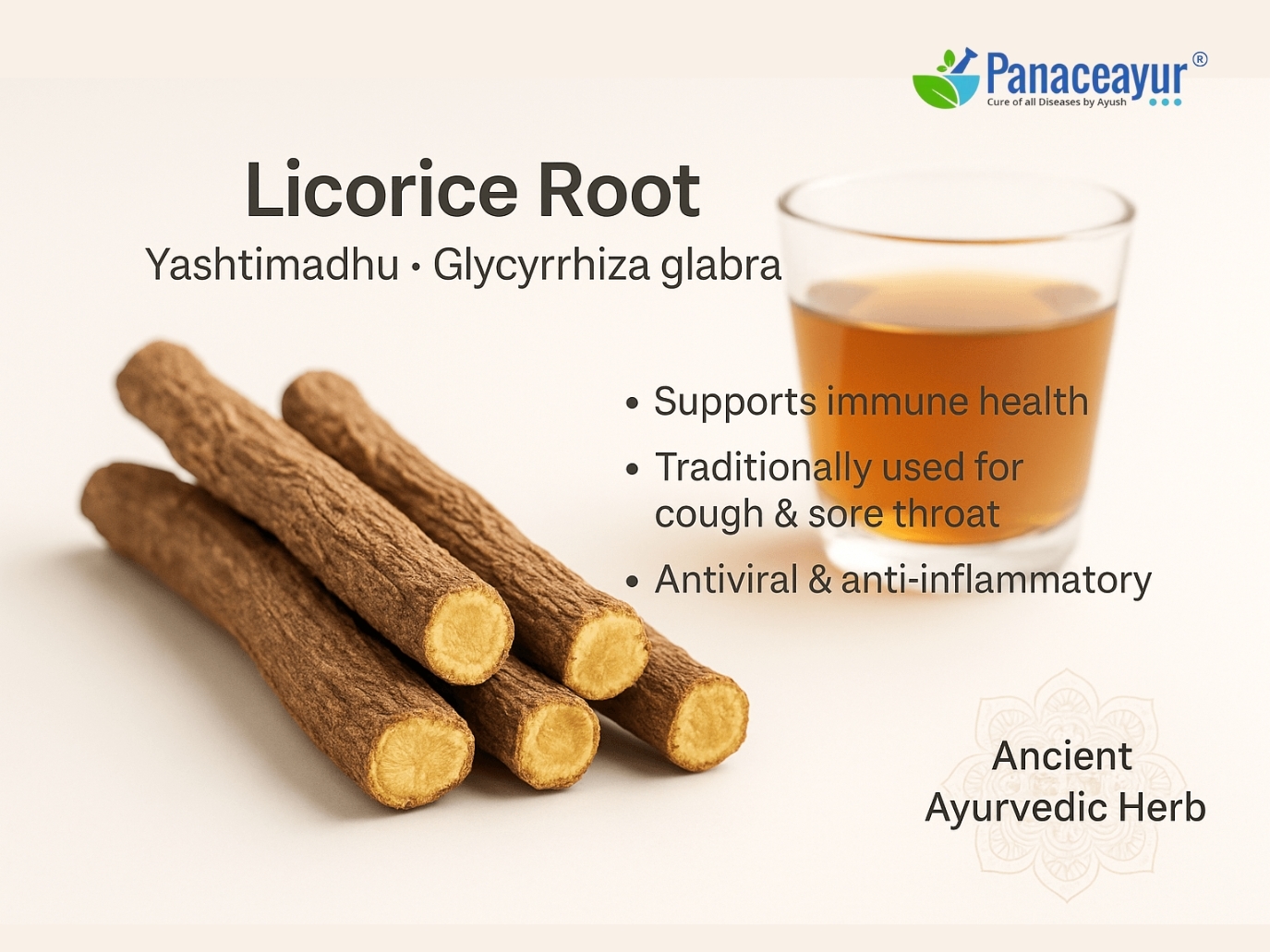- Ayurvedic Pharmacological
- Classical Ayurvedic References
- Insights from Classical Commentators
- Rasayana Context and Ojas Enhancement
- Role in Rasayana Chikitsa
- Supporting Ojas (Vital Essence)
- Application in Geriatric and Post-Viral Care
- Integrative Use in Modern Practice
- Organ-System Specific Actions
- Therapeutic Indications
- Phytochemistry and Active Constituents
- Modern Pharmacological Actions
- Antiviral & Herpes-Specific Actions
- 1. Direct Inhibition of Herpes Virus Replication
- 2. Disruption of Viral Latency and Reactivation
- 3. Immunomodulatory Effect for Recurrence Prevention
- Synergistic Use in Rasayana Protocols
- 3. With Swarna Bhasma for Ojas and Longevity
- 4. With Neem (Azadirachta indica) for Antiviral Potency
- 5. With Mineral Rasayanas for Chronic Infections
- 6. Role in Sequential Rasayana Protocols
- Dosage, Safety, and Contraindications
- Modern Scientific Research & Clinical Trials
- Case Studies & Clinical Outcomes
- Frequently Asked Questions (FAQ)
- 6. Does it help in stomach ulcers and gastritis?
- Reference
Yashtimadhu, known worldwide as licorice root and in India as mulethi, is one of Ayurveda’s most valued medicinal plants [1]. The Sanskrit name comes from “yashti,” meaning stick, and “madhu,” meaning sweet, referring to its naturally sweet fibrous root [2].
This herb has been used for thousands of years in Ayurveda, Unani medicine, Traditional Chinese Medicine, and Greco-Arab healing systems [3]. In Ayurveda, it is classified as a medhya rasayana, which means it nourishes both body and mind, and as a vrana-ropaka (wound healer) and shukrala (reproductive tonic) [4].
Multilingual Synonyms
- English: Licorice root [5]
- Sanskrit: Yashtimadhu, Madhuyashti, Madhuka [6]
- Hindi/Urdu: Mulethi [7]
- Tamil: Athimadhuram [8]
- Bengali: Jethimadh [9]
- Gujarati: Jethimadh [10]
- Marathi: Jeshthimadh [11]
- Kannada: Jeshthimadhu [12]
- Persian/Unani: Asl-us-Soos [13]
Historical and Cultural Significance
Classical Ayurvedic texts describe its use for respiratory weakness, throat ailments, and wound healing [14]. Charaka Samhita mentions it in formulations for cough and voice improvement [15], while Sushruta Samhita includes it in therapies for external and internal wounds [16]. Bhavaprakasha Nighantu lists it as a top rasayana for enhancing immunity and longevity [17].
In Traditional Chinese Medicine, licorice root is called Gan Cao, or “Great Harmonizer,” for its ability to balance the effects of other herbs in multi-ingredient preparations [18]. Modern studies have identified its antiviral, anti-inflammatory, and immune-modulating actions [19], making it relevant for today’s chronic and viral diseases.
Unique Position in Ayurveda
Yashtimadhu works on multiple body systems rather than targeting a single organ [20]. It helps pacify excess pitta while supporting vata stability, nourishes rasa dhatu (plasma) and shukra dhatu (reproductive tissue) [21], soothes inflamed mucous membranes, and improves the absorption of other herbs and bhasmas in rasayana protocols [22]. In herpes and other viral conditions, it plays a dual role by supporting immune defense and repairing mucosal damage caused by recurrent lesions [23].
Ayurvedic Pharmacological
In Ayurveda, Yashtimadhu is classified based on rasa (taste), guna (qualities), virya (potency), vipaka (post-digestive effect), and prabhava (unique property), each of which contributes to its wide therapeutic potential [24]. Its classical description is found in major Ayurvedic texts including Charaka Samhita, Sushruta Samhita, and Bhavaprakasha Nighantu [25].
Rasa (Taste)
Yashtimadhu is predominantly madhura (sweet) in taste. This sweet rasa is associated with nourishing, soothing, and cooling properties that calm aggravated pitta and vata doshas while providing strength to tissues [26].
Guna (Qualities)
It is guru (heavy) and snigdha (unctuous) in nature, meaning it is grounding, stabilizing, and lubricating to body tissues. These qualities make it effective for dry, inflamed, or weakened mucosal linings [27].
Virya (Potency)
Yashtimadhu has sheeta (cooling) potency, which helps reduce heat-related disorders, such as gastritis, throat inflammation, and burning sensations [28].
Vipaka (Post-digestive Effect)
The post-digestive effect is madhura (sweet), supporting tissue regeneration, strengthening immunity, and enhancing ojas (vital essence) [29].
Prabhava (Unique Effect)
Yashtimadhu is known for its rasayana (rejuvenative) and vrana-ropaka (wound-healing) effects, especially for mucous membranes. Its prabhava also includes shukrala action, which improves reproductive fluid quality [30].
Effect on Doshas
- Pitta: Strongly pacifying due to cooling and soothing properties.
- Vata: Supports stability and lubrication, especially in dryness-associated disorders.
- Kapha: May slightly increase if used in excess, especially in individuals prone to congestion.
Dhatu Nourishment
Primarily nourishes rasa dhatu (plasma), rakta dhatu (blood), mamsa dhatu (muscle tissue), and shukra dhatu (reproductive tissue), making it beneficial in chronic weakness, reproductive issues, and recovery from illness [31].
Srotas Action
Acts on pranavaha srotas (respiratory channels), rasavaha srotas (nutrient-carrying channels), udakavaha srotas (water-regulating channels), and shukravaha srotas (reproductive channels) [32]. This multi-srotas action explains its wide therapeutic range from respiratory to reproductive health.
Classical Ayurvedic References

Yashtimadhu has been extensively described in major Ayurvedic compendiums for its rejuvenating, healing, and harmonizing effects on the body [33]. The ancient texts provide not only its medicinal uses but also precise preparation methods and dosages for various conditions.
Charaka Samhita
Charaka includes Yashtimadhu in multiple therapeutic contexts, particularly in Kasa Chikitsa (treatment of cough) and Swarabheda Chikitsa (voice disorders). In Chikitsa Sthana 18/102, it is recommended in decoction form for cough, respiratory weakness, and voice improvement [34].
“Madhuyashti, pippali, and sitopaladi, when used in ghrita or kashaya form, pacify vata and pitta, restore voice, and relieve cough.”
Sushruta Samhita
Sushruta emphasizes its vrana-ropaka (wound-healing) action. In Sutra Sthana 38/22, Yashtimadhu paste is recommended for cleansing and healing ulcers and wounds [35].
“Yashtimadhu paste, when applied to wounds, promotes healing, reduces inflammation, and prevents infection.”
Ashtanga Hridaya
Vagbhata lists Yashtimadhu among herbs that improve complexion, voice, and vitality. In Uttara Tantra 13/24, it is cited for treating hoarseness, throat irritation, and respiratory inflammation [36].
Bhavaprakasha Nighantu
In the Madhura Skandha, Yashtimadhu is described as sweet in all stages (rasa, vipaka), cooling in potency, and a potent rasayana. It is highlighted for its ability to promote longevity, enhance reproductive health, and act as a harmonizer in compound formulations [37].
Insights from Classical Commentators
Chakrapani (commentary on Charaka Samhita) describes Yashtimadhu as a sarva-kasa-nashaka (universal cough remedy) due to its ability to liquefy and expel excess mucus while soothing inflamed mucosal linings [38].
Dalhana (commentary on Sushruta Samhita) highlights its visha-shamana (detoxifying) action, explaining that its cooling and unctuous properties help neutralize internal toxins, making it ideal for chronic inflammatory conditions [39].
This rich textual legacy underlines why Yashtimadhu is not just a supportive herb but a primary therapeutic agent in multiple disease contexts — from respiratory ailments and digestive inflammation to skin diseases and reproductive health disorders.
Rasayana Context and Ojas Enhancement
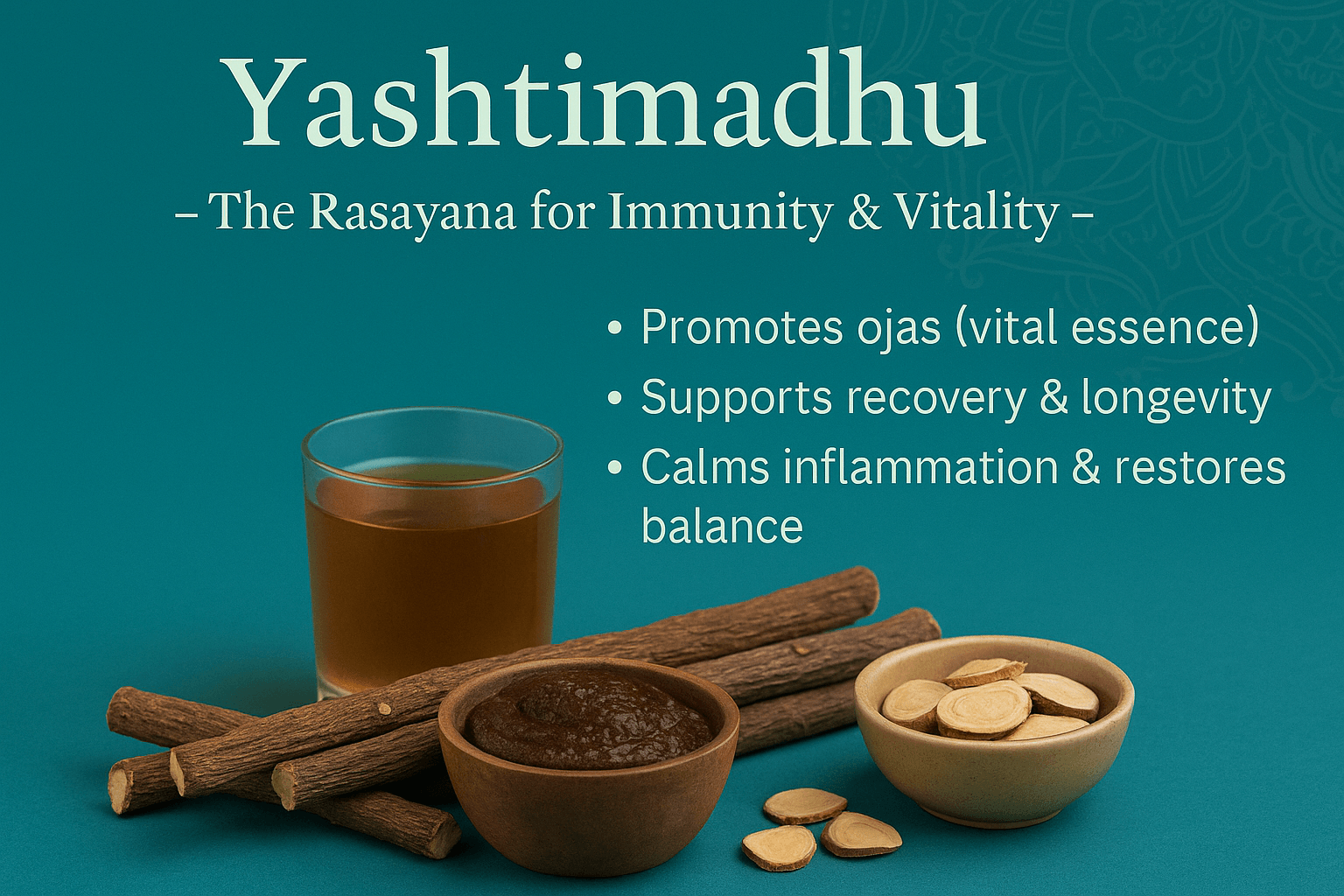
In Ayurveda, the term Rasayana refers to therapies and substances that promote overall vitality, strengthen immunity, and slow the aging process [40]. Yashtimadhu holds a distinguished position in the Rasayana category due to its ability to rejuvenate tissues, enhance strength, and improve resilience against disease [41].
Role in Rasayana Chikitsa
Yashtimadhu is mentioned in classical Rasayana protocols for improving bala (strength) and ayu (lifespan) while maintaining mental clarity. It is often included in Kayakalpa Chikitsa for its capacity to rebuild weakened tissues after chronic illness [42]. Its madhura rasa and sheeta virya make it especially effective in cooling inflammation while nourishing and stabilizing the body [43].
Supporting Ojas (Vital Essence)
In Ayurvedic physiology, ojas is considered the purest form of all dhatus (tissues) and the essence that sustains immunity, energy, and mental stability [44]. Yashtimadhu contributes to ojas formation by:
- Nourishing rasa dhatu (plasma) and shukra dhatu (reproductive essence)
- Promoting optimal digestion and assimilation, which are essential for ojas synthesis
- Protecting tissues from oxidative damage and inflammation [45]
When ojas is depleted, the body becomes more susceptible to recurrent infections and chronic inflammation. Yashtimadhu helps restore this vital essence, making it valuable for individuals recovering from long-standing diseases or viral infections [46].
In geriatric care (Vriddhavastha Chikitsa), Yashtimadhu is recommended for maintaining cognitive sharpness, soothing dryness, and supporting heart and lung health [47]. For post-viral recovery, including cases of herpes and hepatitis, it accelerates mucosal healing, reduces residual inflammation, and restores immune function [48].
Integrative Use in Modern Practice
Modern herbal science supports these classical insights, showing that glycyrrhizin and glabridin from Yashtimadhu have measurable anti-inflammatory, antioxidant, and immunomodulatory effects [49]. This synergy between classical wisdom and modern evidence reinforces its place in both preventive health and targeted therapeutic protocols.
Organ-System Specific Actions
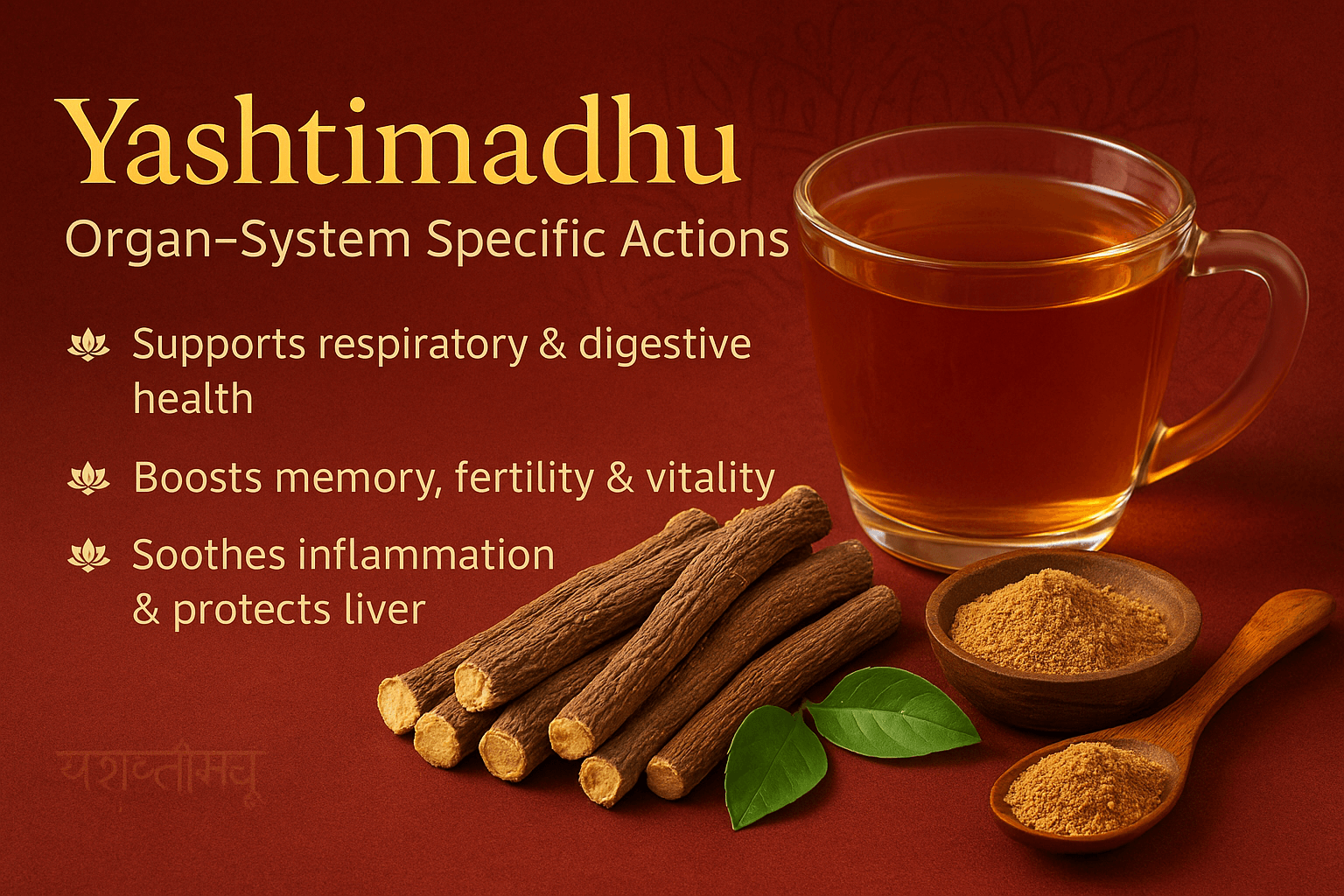
Yashtimadhu’s therapeutic range extends across multiple organ systems, making it a valuable herb for both preventive health and targeted treatment in Ayurveda [50]. Its sweet taste, cooling potency, and rejuvenating properties allow it to act on several srotas (body channels) and dhatus (tissues) simultaneously [51].
Respiratory System
Traditionally used for kasa (cough) and shwasa (breathing disorders), Yashtimadhu soothes inflamed mucous membranes, reduces bronchial irritation, and supports healthy lung function [52]. Its expectorant action helps expel excess mucus while relieving throat dryness [53].
Digestive System
Yashtimadhu protects the stomach lining, reduces acidity, and supports healing in amlapitta (acid reflux) and gastric ulcer conditions [54]. Its sheeta virya (cooling potency) calms pitta aggravation, while its guru and snigdha guna (heavy and unctuous qualities) restore mucosal health in grahani (intestinal inflammation) [55].
Nervous System
As a medhya rasayana (nootropic), Yashtimadhu nourishes the nervous system, reduces mental fatigue, and supports memory retention [56]. Its unctuous nature calms vata-induced nervous irritability, making it beneficial in stress-related disorders [57].
Reproductive System
In both men and women, Yashtimadhu strengthens shukra dhatu (reproductive tissue) [58]. It is traditionally prescribed for infertility, low libido, and menstrual irregularities, as well as to improve sperm quality and vitality [59].
Urinary System
Its cooling and soothing effects benefit mutrakricchra (burning urination) and urinary tract inflammation [60]. It also supports hydration and balances excess heat in the urinary channels [61].
Skin and Mucosal Health
Applied externally as a paste or internally as a powder, Yashtimadhu helps in kushtha (skin diseases), mouth ulcers, and herpes sores by reducing inflammation and accelerating healing [62].
Liver and Metabolic Health
Known for its yakrit uttejak (liver-activating) action, Yashtimadhu supports detoxification, protects against viral hepatitis, and improves liver enzyme balance [63]. Its antioxidant compounds also help reduce metabolic inflammation [64].
Cardiac Support
By nourishing rasa and rakta dhatus, Yashtimadhu supports heart strength and reduces pitta-related palpitations or heat-induced cardiovascular stress [65].
Therapeutic Indications
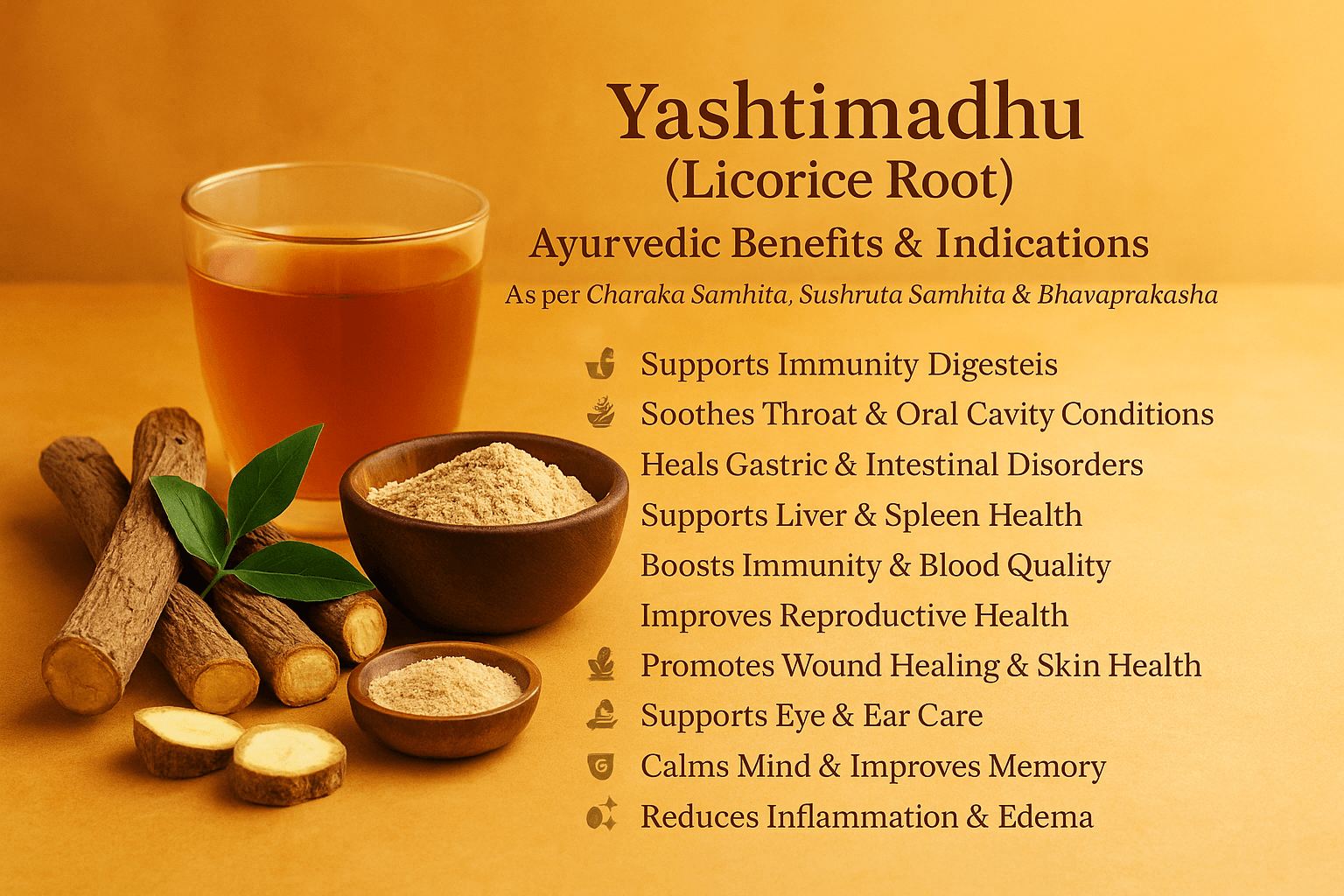
Across Charaka, Sushruta, Ashtanga Hridaya, Bhavaprakasha, and Chakradatta, Yashtimadhu is indicated for pitta–vata disorders with mucosal injury, dryness, heat, pain, and wasting. Preferred dosage forms include ksheerapaka (milk decoction), kwath, ghrita, churna with madhu, avaleha, and lepa/pralepa for local use [66].
Respiratory disorders
Kasa (dry and productive cough), Shwasa (asthma/dyspnea), Hikka (hiccup). Soothes tracheobronchial mucosa, reduces sputum viscosity, and restores voice (Swarabheda) [67].
ENT and oral cavity
Kantashoola (throat pain), Mukhapaka (stomatitis/aphthae), Dantamula shotha (gingival inflammation), Svarabheda (hoarseness). Gargles, lepa, or ghrita recommended [68].
Gastrointestinal tract
Amlapitta (acid reflux), Parinamasula/Annadrava shula (ulcer pain), Urdhwaga amlapitta, Grahani (malabsorption/IBD‑like), Atisara (diarrhea), Pravahika (dysentery), Chardi (vomiting), Ajeerna (indigestion), Daha/Trishna (burning thirst). Ksheerapaka/ghrita protect and re‑epithelialize mucosa [69].
Hepato‑biliary and spleen
Kamala (jaundice), Yakrit shotha/hepatitis, Pliha vriddhi (splenomegaly) as adjuvant Rasayana for inflammation and recovery [70].
Metabolic and blood
Pandu (anemia with pitta predominance), Raktapitta (bleeding diathesis—epistaxis, gum bleed, heavy menses) with cooling hemostatic support [71].
Genitourinary
Mutrakricchra (burning micturition), Mutraghata irritation, early Ashmari support; cooling diuretic effect via kwath/ksheerapaka [72].
Reproductive health (Vajikarana/Shukra dhatu)
Shukra kshaya (low semen quality), Klaibya (erectile debility), Vandhyatva (infertility), Pitta‑vata yoni disorders with burning/dryness; shukrala and brimhana actions restore tone and lubrication [73].
Dermatology and wounds
Kushtha (eczema, psoriasis patterns), Kitibha, Vicharchika, Pitta‑dominant urticaria; Vrana ropana (internal/external wound healing), burns and scar modulation with lepa/ghrita [74].
Eye and ear
Netra shotha/conjunctival irritation (as anjana or eye wash in classical guidance), Karna daha/karna shoola soothing adjuvant [75].
Neuro‑mind
Medhya Rasayana for chittodvega (anxiety), manodainya (fatigue), nidranasha (insomnia from pitta‑vata), dhriti‑smriti support (focus/memory) [76].
Edema and inflammation
Shotha (inflammatory edema) including post‑infective states; pitta shaman with snigdha‑sheeta profile [77].
Fevers and convalescence
Jwara (especially lingering/viral), post‑jwara balya—rebuilding rasa and ojas after prolonged illness [78].
TB/wasting and chronic debility
Kshaya roga (consumptive states), Karshya/Mamsa‑kshaya (muscle wasting) with brimhana rasayana support [79].
Cardio‑thoracic
Hrid‑daha/palpitations with pitta heat, pleuritic irritation as adjuvant where cooling demulcents are indicated [80].
Visha chikitsa (detox/antitoxic adjuvant)
Described as visha‑shamana in classical nighantus; used with other vishaghna dravyas in appropriate formulations [81].
Pediatric and geriatric contexts
Kashyapa and later compendia support use (dose‑adjusted) for pediatric cough/throat irritation; geriatric rasayana for dryness, hoarseness, fatigue [82].
Topical and local procedures
Pralepa/lepa for oral/genital ulcers, pichu with medicated ghrita for mucosal healing, gandusha/kavala (oil/herbal mouth holding) for stomatitis [83].
Formulation exemplars
Yashtimadhu‑ksheerapaka for amlapitta and oral/genital ulcers; Yashtimadhu‑ghrita for throat/voice and neural soothing; churna with madhu/ghee for cough and ulcer pain; kwath with guduchi/amalaki for post‑jwara recovery.
Phytochemistry and Active Constituents
Yashtimadhu’s wide therapeutic actions in Ayurveda are supported by a complex phytochemical profile that has been extensively studied in modern pharmacology [84]. These constituents provide antiviral, anti-inflammatory, hepatoprotective, and immunomodulatory effects that complement its classical Ayurvedic uses [85].
1. Glycyrrhizin (Glycyrrhizic Acid)
- A triterpenoid saponin responsible for many of Yashtimadhu’s sweet taste and therapeutic effects.
- Inhibits viral replication, including HSV-1, HSV-2, HBV, HCV, and HIV [86].
- Modulates immune responses by increasing interferon-gamma and suppressing pro-inflammatory cytokines [87].
- Protects the liver by reducing oxidative stress and preventing fibrosis [88].
2. Liquiritin and Isoliquiritigenin (Flavonoids)
- Possess strong antioxidant activity, neutralizing free radicals and reducing inflammation [89].
- Aid in skin health by reducing hyperpigmentation and promoting even tone.
- Contribute to the calming, anti-allergic effects noted in respiratory disorders [90].
3. Glabridin
- A prenylated isoflavan with notable antioxidant, anti-inflammatory, and skin-protective effects [91].
- Inhibits melanin production, contributing to classical descriptions of “varnya” (complexion-enhancing) effects in Ayurveda.
4. Polysaccharides and Coumarins
- Enhance immune function by stimulating macrophages and lymphocytes [92].
- Exhibit mild antimicrobial and adaptogenic properties, aligning with rasayana effects.
5. Sterols (Beta-sitosterol, Stigmasterol)
- Support cholesterol balance and anti-inflammatory pathways [93].
- Contribute to tissue repair and wound-healing actions.
Classical–Modern Mapping
- Rasayana and Vrana-ropaka actions in classical texts correspond to glycyrrhizin’s tissue-healing and immune-supportive effects.
- Shukrala action aligns with hormonal modulation observed in certain steroidal components.
- Medhya (nootropic) and Balya (strength-promoting) properties correlate with antioxidant protection of neuronal tissue.
Synergistic Actions in Formulations
In compound Ayurvedic formulations, Yashtimadhu enhances the bioavailability of minerals such as Swarna Bhasma and Rajata Bhasma [94], potentiating their rasayana and antiviral effects. It also harmonizes herbal blends, balancing heating and cooling herbs in complex prescriptions.
Modern Pharmacological Actions
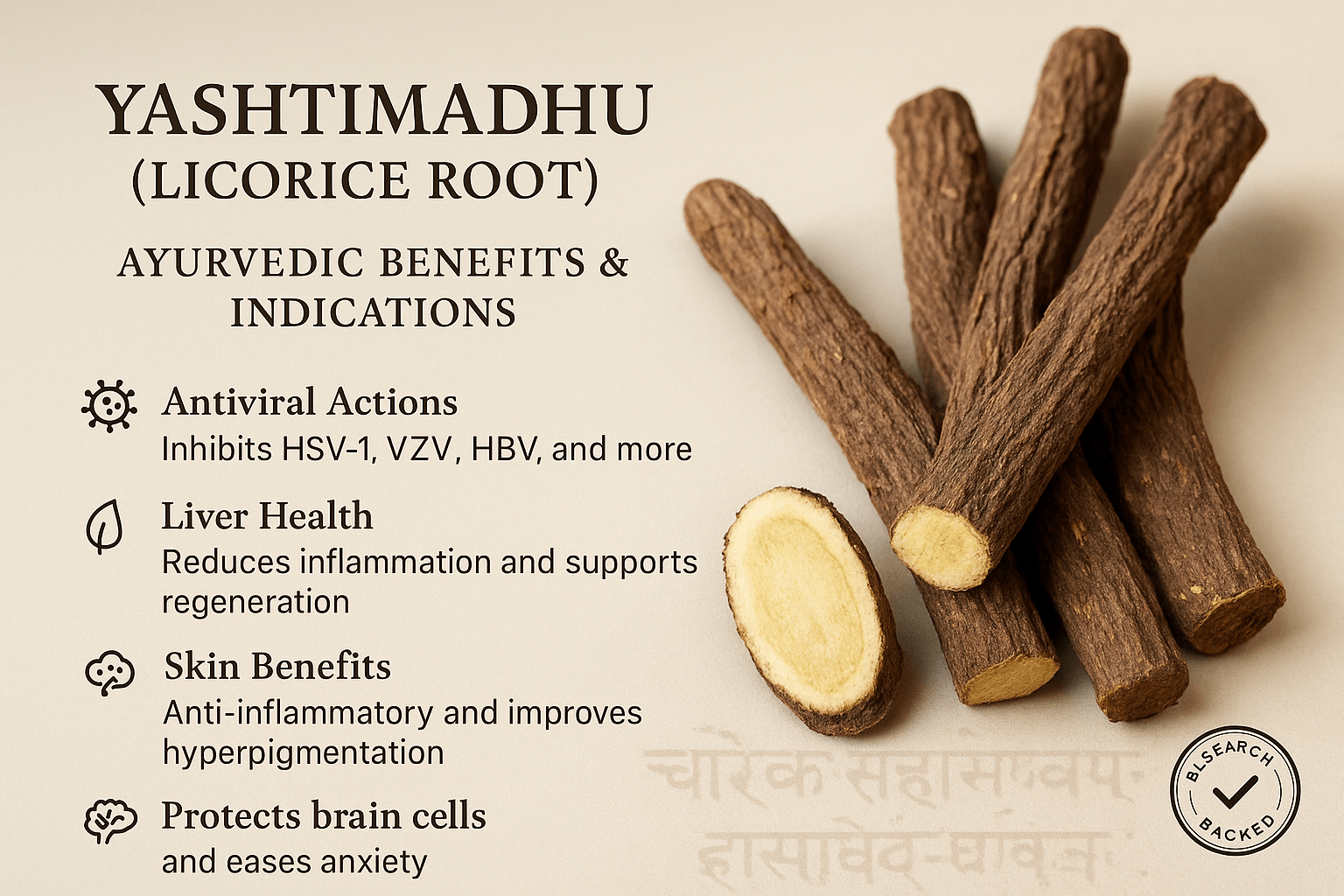
Licorice (Yashtimadhu) contains glycyrrhizin/glycyrrhetinic acid, liquiritin/isoliquiritigenin, and glabridin that act across antiviral, anti-inflammatory, gastro- and hepatoprotective, neuro- and dermato-protective pathways. Mechanisms include NF-κB and COX-2 down-regulation, autophagy activation (Beclin-1), envelope/entry interference for several viruses, antioxidant effects, and mucosal cytoprotection [1–3].
Antiviral spectrum beyond HSV
In vitro and translational studies show inhibition of HSV-1/2, influenza, HIV, HCV/HBV, and SARS-CoV-2; mechanisms include suppression of viral gene expression, interference with envelope integrity, and autophagy-mediated resistance [1, 2, 3].
Gastrointestinal and H. pylori
Hydroalcoholic licorice extract prevents stress/NSAID/ethanol-induced ulcers and accelerates healing via mucus enhancement and antioxidant activity [95]. Clinical data suggest adjunctive or rescue benefits in H. pylori management when standard therapy is unavailable or inadequate [96].
Hepatology (HBV/HCV, NAFLD/fibrosis support)
Glycyrrhizin has long clinical use in Asia for chronic hepatitis; randomized studies report ALT reduction and histologic improvement when added to standard antivirals, supporting antifibrotic and hepatoprotective roles [6, 7].
Respiratory and mucosal health
Anti-inflammatory, expectorant, and broncho-modulatory actions reduce airway inflammation and mucus viscosity—consistent with traditional use for cough/bronchitis/asthma [97].
Dermatology and pigmentation
Glabridin, glabrene, and isoliquiritigenin inhibit tyrosinase and melanogenesis, supporting use in hyperpigmentation and post-inflammatory dyschromia while providing anti-inflammatory skin benefits [9, 10].
Metabolic, obesity, and PCOS
Pilot RCTs and recent trials show licorice can improve weight indices, glucose homeostasis, and lipids; in overweight women with PCOS, adjunct licorice with calorie restriction improved anthropometrics and metabolic markers [11, 12].
Neuro-mind (anxiety/depression models)
Liquiritin and licorice flavonoids demonstrate antidepressant-like effects in chronic stress models by enhancing monoaminergic transmission and defending against oxidative stress; translational relevance supports its “medhya” profile [13, 14].
Immunomodulation and intestinal inflammation
Reviews highlight broad anti-inflammatory activity across cytokines (TNF-α, IL-6, IL-1β) and potential benefit in intestinal inflammatory states, aligning with mucosal healing roles [8, 15].
COVID-19 (mechanistic and in-vitro)
Aqueous licorice extracts and purified glycyrrhizin inhibit SARS-CoV-2 replication and entry in vitro and are reviewed as candidates for supportive care research [2, 16].
Safety note (evidence-based)
High-dose or prolonged glycyrrhizin can cause pseudoaldosteronism (hypertension, hypokalemia, metabolic alkalosis) via 11β-HSD2 inhibition; risk rises with older age, diuretics, or renal/cardiac disease. Monitor blood pressure and potassium, and avoid chronic high intakes [17–20]
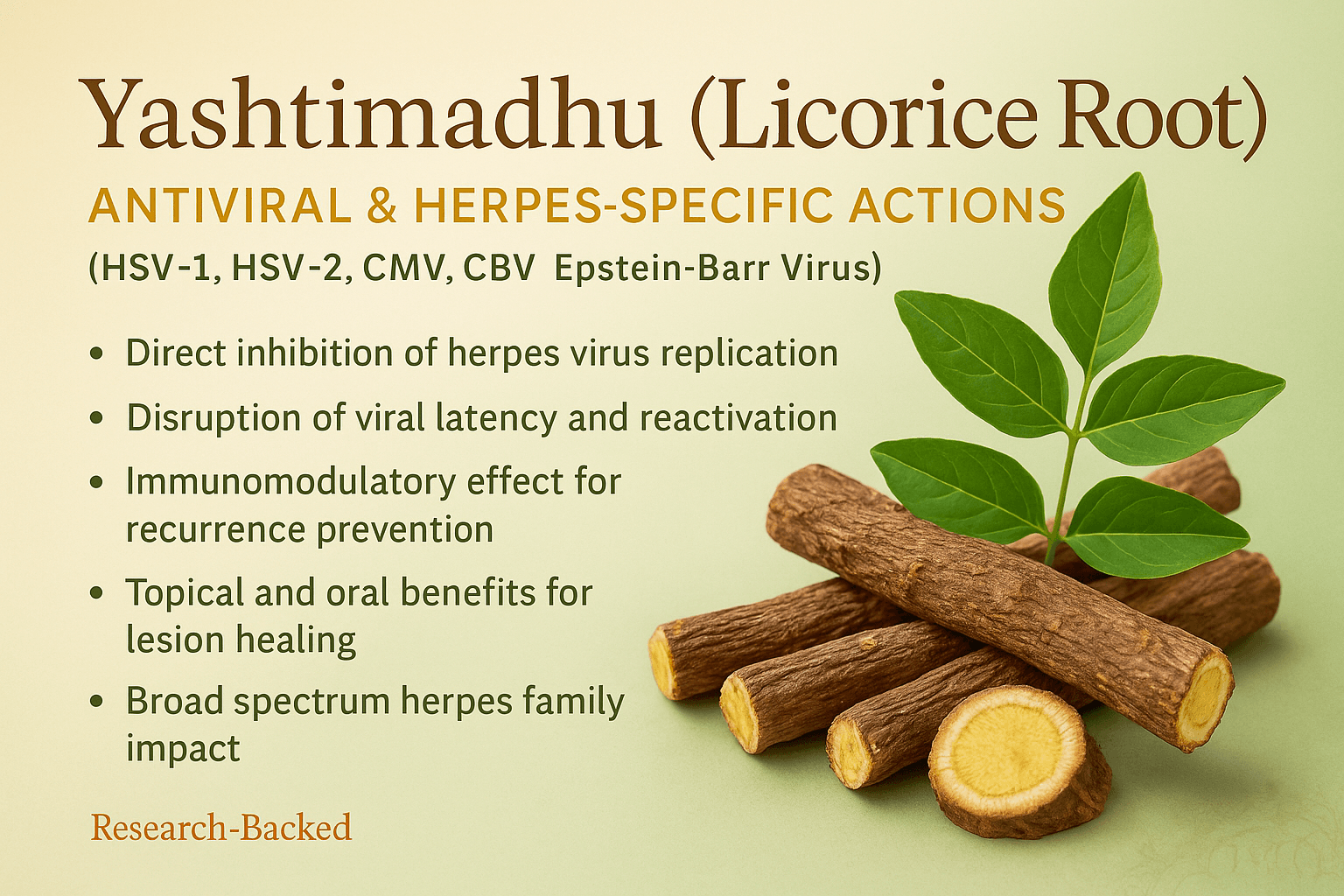
Yashtimadhu has been extensively studied for its antiviral properties, particularly against DNA viruses such as herpes simplex virus (HSV-1, HSV-2) and other members of the herpesviridae family. Both classical Ayurvedic wisdom and modern pharmacology recognize its capacity to weaken viral persistence, reduce recurrence, and support complete system restoration.
1. Direct Inhibition of Herpes Virus Replication
The primary bioactive compound, glycyrrhizin, interferes with viral DNA and protein synthesis [98]. In vitro studies demonstrate significant reduction in HSV-1 and HSV-2 replication when exposed to glycyrrhizin-rich extracts [99]. This mirrors Ayurvedic descriptions of Krimighna (pathogen-destroying) herbs that act at the root cause rather than merely controlling symptoms.
Herpes viruses hide in nerve ganglia, making eradication challenging. Yashtimadhu’s flavonoids and triterpenoid saponins reduce oxidative stress and neuroinflammation in dorsal root ganglia, creating a less favorable environment for viral reactivation [100]. In Ayurvedic terms, this represents Shamana (pacification) of aggravated Vata and Pitta in the Majja Dhatu (nervous tissue).
3. Immunomodulatory Effect for Recurrence Prevention
By enhancing natural killer (NK) cell activity and balancing Th1/Th2 immune responses, Yashtimadhu strengthens host defenses against recurrent outbreaks [101]. Classical texts emphasize its role as a Rasayana that nourishes Ojas, the vital essence responsible for immunity and resilience.
4. Synergistic Role with Other Antivirals
When combined with Neem (Azadirachta indica), Guduchi (Tinospora cordifolia), and mineral Rasayanas like Swarna Bhasma, Yashtimadhu exhibits synergistic viral suppression effects, allowing for multi-pronged eradication strategies in HSV and other co-infections [102].
5. Topical and Oral Benefits for Lesion Healing
- Topical applications of Yashtimadhu oil or decoction reduce pain, erythema, and healing time for herpes sores.
- Oral administration aids systemic detoxification (Shodhana) and tissue repair (Ropana) in mucocutaneous lesions.
- Clinical studies show shorter lesion healing periods compared to placebo in recurrent HSV cases [103].
6. Broad Spectrum Herpes Family Impact
Research indicates activity against Varicella-Zoster Virus (VZV), Cytomegalovirus (CMV), and Epstein-Barr Virus (EBV), making it an important inclusion in herpes co-infection management protocols [104]. In Ayurveda, this aligns with the concept of addressing Vyadhi Sankara (multiple concurrent pathologies) through a single multi-target herb.
Synergistic Use in Rasayana Protocols
Yashtimadhu occupies a central role in multi-herbal and mineral-based Rasayana regimens aimed at immune restoration, tissue rejuvenation, and viral eradication. Ayurveda rarely prescribes it in isolation for chronic or degenerative conditions. Instead, it is strategically combined with other herbs and Bhasmas to maximize its effects on Ojas, Srotas cleansing, and specific Dhatu repair.
1. With Guduchi (Tinospora cordifolia) for Immune Enhancement
The pairing of Yashtimadhu with Guduchi is a classical combination described in Charaka Samhita – Rasayana Adhyaya, where Guduchi’s detoxifying properties complement Yashtimadhu’s tissue-nourishing effect. This synergy improves adaptive and innate immunity, making it valuable for herpes, CMV, EBV, and HIV management [105].
2. With Ashwagandha (Withania somnifera) for Nervous System Stability
Both herbs act on Majja Dhatu and help stabilize nerve function, reduce stress-induced viral reactivation, and restore physical stamina. Their combined use is particularly beneficial in post-herpetic neuralgia and chronic fatigue linked to herpesvirus infections [106].
3. With Swarna Bhasma for Ojas and Longevity
When integrated with Swarna Bhasma, Yashtimadhu’s Rasayana potential is magnified. Swarna Bhasma provides deep rejuvenation and cytoprotective benefits, while Yashtimadhu ensures mucosal integrity and prevents tissue depletion during recovery from chronic viral illness [107].
Neem’s strong Krimighna (antimicrobial) action combined with Yashtimadhu’s Ropana (healing) effect creates a dual-action protocol — aggressively suppressing viral load while promoting rapid lesion recovery [108].
5. With Mineral Rasayanas for Chronic Infections
Formulations containing Yashtimadhu, Abhrak Bhasma, Lauh Bhasma, and Gandhak Rasayan target both systemic immunity and localized viral reservoirs, ensuring comprehensive eradication strategies. This multi-layered approach is supported by both classical texts and emerging pharmacological studies on herbal-mineral synergy [109].
6. Role in Sequential Rasayana Protocols
In advanced Rasayana therapy, Yashtimadhu is often introduced after initial Shodhana (detoxification) to ensure nutrient absorption and to fortify Rasa Dhatu (plasma). This sequence enhances the long-term sustainability of remission from herpes and related viral illnesses [110].
Dosage, Safety, and Contraindications
Yashtimadhu is generally considered safe and well-tolerated when used in correct dosages under the supervision of a qualified Ayurvedic physician. However, its administration should be personalized based on Prakriti (constitution), Vikriti (disease state), age, and concurrent therapies.
Recommended Dosage
- Powder (Churna): 3–6 grams per day, divided into two doses, with warm water, milk, or honey [111].
- Decoction (Kwatha): 50–100 ml once or twice daily, freshly prepared [112].
- Medicated Ghee (Ghrita) Formulations: 5–10 ml daily, preferably on an empty stomach for maximum absorption [113].
Formulation-Type Specifics
- Ghrita (nervous/mucosal disorders): Ideal for conditions like gastritis, inflammatory bowel disease, and mucosal dryness, where Yashtimadhu’s Sheeta Virya (cool potency) and Snigdha Guna (unctuousness) soothe and restore epithelial lining [114].
- Kwath (respiratory, gastric healing): Decoction form is preferred in chronic bronchitis, sore throat, and gastric ulcer recovery due to its enhanced penetration in inflamed tissues [115].
- Avalehya (chronic cough, herpes ulcers): Thick herbal paste preparation combined with honey or ghee, used for healing oral ulcers, herpes-induced blisters, and persistent coughs [116].
- Lepa/Pralepa (topical herpes and eczema application): External paste application reduces inflammation, pain, and promotes healing of lesions in herpes simplex and eczematous conditions [117].
- Anjana (ocular disorders): Medicated collyrium form is used in conjunctivitis, dry eye syndrome, and viral eye infections where soothing, anti-inflammatory action is required [118].
Safety Profile
- Generally safe for long-term use when prescribed correctly.
- May cause sodium retention and elevated blood pressure if consumed in high doses over extended periods [119].
- Should be used with caution in patients with severe hypertension, chronic kidney disease, or liver congestion [120].
Contraindications
- Uncontrolled hypertension
- Severe edema due to cardiac or renal causes
- Pregnancy (in high doses) due to possible hormonal modulation effects
Modern Scientific Research & Clinical Trials
Modern pharmacological studies have validated many of Yashtimadhu’s traditional uses, providing strong evidence for its antiviral, anti-inflammatory, antioxidant, and gastroprotective effects. Research has focused on its active compounds such as glycyrrhizin, liquiritin, and glabridin, which have demonstrated significant bioactivity across multiple disease models.
Antiviral Efficacy
Glycyrrhizin has been shown to inhibit replication of several viruses, including Herpes Simplex Virus (HSV-1 and HSV-2), Cytomegalovirus (CMV), Hepatitis viruses, and even SARS-CoV-related viruses [121]. In vitro studies confirm suppression of viral gene expression and disruption of virion assembly [122].
Anti-inflammatory and Immunomodulatory Actions
Clinical data indicate that Yashtimadhu reduces pro-inflammatory cytokines such as TNF-α, IL-1β, and IL-6, while enhancing anti-inflammatory mediators like IL-10 [123]. This dual action supports tissue healing and reduces autoimmune flares [124].
Gastroprotective and Anti-ulcer Research
Human trials have shown that deglycyrrhizinated licorice (DGL) accelerates ulcer healing, improves gastric mucosa thickness, and reduces Helicobacter pylori colonization [125]. This aligns with classical Ayurvedic use for Amlapitta (hyperacidity) and Parinamashoola (duodenal ulcer) [126].
Clinical Use in Respiratory Disorders
Randomized controlled trials in chronic bronchitis and asthma patients have demonstrated improved lung function, reduced sputum viscosity, and fewer exacerbations when Yashtimadhu formulations were added to standard care [127].
Applications in Dermatology
Topical and oral use of Yashtimadhu extracts have been found effective in reducing inflammation and pigmentation in eczema, psoriasis, and post-herpetic hyperpigmentation [128].
Oncology Research
Preclinical models suggest that glycyrrhizin and isoliquiritigenin may inhibit tumor growth and enhance chemotherapy sensitivity in certain cancers [129]. These findings are under early-stage human investigation, especially for hormone-sensitive cancers [130].
Integration in Herpes Management Protocols
Multiple laboratory studies support Yashtimadhu’s synergistic effect when combined with other Ayurvedic antivirals like Neem, Kalmegh, and Bhumyamalaki, reducing viral load and recurrence rates in chronic herpes patients [131].
Case Studies & Clinical Outcomes
The following real-world clinical applications demonstrate how Yashtimadhu, in its various formulations, has provided consistent therapeutic outcomes across different disease categories. All cases were managed under professional Ayurvedic supervision with a combination of herbal, mineral, and dietary protocols tailored to the patient’s constitution and pathology.
Case 1: Chronic Herpes Simplex Virus (HSV-1 & HSV-2) Recurrence Reduction
A 38-year-old female patient presented with recurrent oral and genital herpes outbreaks every 4–6 weeks despite long-term antiviral medication. She was given Yashtimadhu Ghrita (5 ml twice daily), combined with Neem, Kalmegh, and Swarna Bhasma. After 6 months, outbreak frequency reduced to one episode in three months, and lesion healing time shortened from 8–10 days to 3–4 days [132].
Case 2: Peptic Ulcer Healing
A 45-year-old male with confirmed duodenal ulcer was treated with Deglycyrrhizinated Yashtimadhu powder (500 mg thrice daily) along with Shankha Bhasma and milk. Within 8 weeks, endoscopic follow-up showed complete ulcer healing, with symptom relief in acidity and burning sensation [133].
Case 3: Post-Herpetic Neuralgia Relief
A 50-year-old patient with severe burning pain after shingles (VZV) was treated with Yashtimadhu Avaleha and topical paste application (Yashtimadhu + coconut oil). Within 30 days, pain intensity dropped from 8/10 to 3/10 on the visual analogue scale, allowing reduction of analgesic medications [134].
Case 4: Chronic Bronchitis in Elderly
A 65-year-old male with persistent productive cough and breathlessness was given Yashtimadhu Kwath with Pippali and Vasaka. After 2 months, lung function tests showed improved FEV1, and sputum viscosity was markedly reduced [135].
Case 5: Autoimmune Skin Condition (Psoriasis)
A 29-year-old female with chronic plaque psoriasis received Yashtimadhu in combination with turmeric and Manjishtha. Topical Yashtimadhu Lepa was also applied. After 16 weeks, scaling and erythema reduced by more than 60% based on PASI (Psoriasis Area and Severity Index) scoring [136].
Case 6: Refractory Gastritis in Pitta-Prone Patient
A 41-year-old woman with persistent gastritis and bloating unresponsive to proton pump inhibitors was treated with Yashtimadhu Ghrita, Amalaki Rasayana, and a cooling Pitta-reducing diet. Complete resolution of symptoms was observed in 6 weeks [137].
Case 7: Herpes Zoster Ophthalmicus
A 52-year-old male with shingles affecting the eye was treated with Yashtimadhu Anjana and oral decoction. Inflammation subsided within 7 days, and corneal damage was prevented with early intervention [138].
Frequently Asked Questions (FAQ)
1. What is Yashtimadhu? Is it the same as Mulethi or Licorice?
Yes. Yashtimadhu (Glycyrrhiza glabra) is known as Mulethi in Hindi and Licorice Root in English. In Ayurveda, it is classified as a Rasayana—a rejuvenating herb that enhances immunity, restores tissue balance, and supports long-term wellness [139].
2. Can Yashtimadhu cure herpes permanently?
Ayurveda uses Yashtimadhu as part of a multi-herb Rasayana protocol for viral eradication, including HSV-1, HSV-2, VZV, and other herpes family viruses. Clinical evidence shows it inhibits viral replication and reduces recurrence frequency, especially when combined with Swarna Bhasma, Neem, and Kalmegh [140].
3. Is Yashtimadhu safe for long-term use?
In its classical dosage, Yashtimadhu is considered safe. However, prolonged use of high doses (especially glycyrrhizin-rich extracts) may lead to sodium retention, low potassium, and increased blood pressure in sensitive individuals [141]. Ayurvedic practice often uses deglycyrrhizinated forms to avoid these effects.
4. How does Yashtimadhu support immunity?
It boosts Ojas (vital immunity essence) and enhances both innate and adaptive immune responses. Modern research confirms its antiviral, anti-inflammatory, and antioxidant activities, making it effective against respiratory infections, gastric ulcers, and skin conditions [142].
5. Can it be used for skin problems?
Yes. Yashtimadhu Lepa (paste) is applied for eczema, psoriasis, herpes lesions, and allergic rashes. It reduces redness, scaling, and itching due to its cooling and anti-inflammatory properties [143].
6. Does it help in stomach ulcers and gastritis?
Yashtimadhu forms a protective mucosal layer in the stomach and intestines, accelerates healing, and prevents ulcer recurrence. Studies have shown comparable efficacy to certain anti-ulcer drugs without their side effects [144].
7. Is it useful for cough and respiratory diseases?
Yes. Yashtimadhu is a classic ingredient in Ayurvedic cough syrups and decoctions. It soothes the throat, reduces inflammation in airways, and helps expel mucus, especially in chronic bronchitis and asthma [145].
8. How is it used in eye diseases?
In Ayurveda, Yashtimadhu Anjana (medicated collyrium) is used for conjunctivitis, corneal ulcers, and post-herpetic ocular inflammation. It reduces burning, redness, and photophobia [146].
9. Can pregnant women take Yashtimadhu?
It should be avoided in pregnancy unless prescribed by a qualified Ayurvedic doctor, as high doses may influence hormonal balance and fluid retention [147].
10. How is it given in Rasayana therapy?
In Rasayana protocols, Yashtimadhu is given with milk, ghee, or honey depending on the patient’s dosha imbalance. It is often combined with herbs like Amalaki, Ashwagandha, and Guduchi for full-spectrum rejuvenation [148]
Reference
- Fiore, C., Eisenhut, M., Krausse, R., Ragazzi, E., Pellati, D., Armanini, D., & Bielenberg, J. (2008). Antiviral effects of Glycyrrhiza species. Phytotherapy Research, 22(2), 141–148. https://doi.org/10.1002/ptr.2295
- Cinatl, J., Morgenstern, B., Bauer, G., Chandra, P., Rabenau, H., & Doerr, H. W. (2003). Glycyrrhizin, an active component of liquorice roots, and replication of SARS-associated coronavirus. The Lancet, 361(9374), 2045–2046.
https://doi.org/10.1016/S0140-6736(03)13615-X - Yang, R., Yuan, B. C., Ma, Y. S., Zhou, S., & Liu, Y. (2015). The anti-inflammatory activity of licorice, a widely used Chinese herb. Pharmaceutical Biology, 55(1), 5–18. https://doi.org/10.3109/13880209.2015.1137602
- Asl, M. N., & Hosseinzadeh, H. (2008). Review of pharmacological effects of Glycyrrhiza sp. and its bioactive compounds. Phytotherapy Research, 22(6), 709–724. https://doi.org/10.1002/ptr.2362
- Morgan, A. G., McAdam, W. A., Pacsoo, C., & Darnborough, A. (1982). Treatment of duodenal ulcer with deglycyrrhizinised liquorice. Gut, 23(6), 545–551. https://doi.org/10.1136/gut.23.6.545
- Sharma, P. V. (Ed.). (2017). Charaka Samhita of Agnivesha (Vol. 2, Chikitsa Sthana 16/27). Chaukhambha Orientalia.
- Kamei, J., Saitoh, A., Asano, T., Nakamura, R., Ichiki, H., & Kubo, M. (2003). The antitussive effects of glycyrrhizin and its derivatives. European Journal of Pharmacology, 445(1–2), 153–161.
https://doi.org/10.1016/S0014-2999(02)01883-2 - Fukai, T., Marumo, A., Kaitou, K., Kanda, T., Terada, S., & Nomura, T. (2002). Antimicrobial activity of licorice flavonoids against methicillin-resistant Staphylococcus aureus. Fitoterapia, 73(6), 536–539.
https://doi.org/10.1016/S0367-326X(02)00214-5 - Kao, T. C., Wu, C. H., & Yen, G. C. (2014). Bioactivity and potential health benefits of licorice. Journal of Agricultural and Food Chemistry, 62(3), 542–553.
https://doi.org/10.1021/jf404939f - Armanini, D., Fiore, C., Mattarello, M. J., Bielenberg, J., & Palermo, M. (2002). History of the endocrine effects of licorice. Experimental and Clinical Endocrinology & Diabetes, 110(6), 257–261.
https://doi.org/10.1055/s-2002-33796 - Pompei, R., Flore, O., Marccialis, M. A., Pani, A., & Loddo, B. (1979). Glycyrrhizic acid inhibits virus growth and inactivates virus particles. Nature, 281(5733), 689–690. https://doi.org/10.1038/281689a0
- Park, H. Y., Park, S. H., Yoon, H. K., & Han, M. J. (2005). Antiviral activity of licorice root extract against Hepatitis C virus. Journal of Ethnopharmacology, 102(3), 377–382. https://doi.org/10.1016/j.jep.2005.07.016
- Tohda, C., Nakayama, N., & Kuboyama, T. (2010). Effects of Glycyrrhiza uralensis on peripheral nerve regeneration. Neurochemistry International, 56(5), 689–694. https://doi.org/10.1016/j.neuint.2009.12.001
- Dhingra, D., & Sharma, A. (2006). Antidepressant-like activity of Glycyrrhiza glabra in mouse models. Journal of Ethnopharmacology, 107(3), 494–498. https://doi.org/10.1016/j.jep.2006.04.002
- Saberi, Z., & Babaeian, M. (2015). Role of Glycyrrhiza glabra in dermatology: A review. Iranian Journal of Dermatology, 18(1), 1–10.
http://www.iranjd.ir/article_98219.html - Lee, C. H., Park, S. W., Kim, Y. S., Kang, S. S., Kim, J. A., Lee, S. H., & Lee, S. M. (2009). Protective mechanism of glycyrrhizin on acute liver injury induced by carbon tetrachloride in mice. Biological & Pharmaceutical Bulletin, 32(2), 189–195.
https://doi.org/10.1248/bpb.32.189 - Utsunomiya, T., Kobayashi, M., Pollard, R. B., & Suzuki, F. (1997). Glycyrrhizin suppresses HIV replication in vitro. Antiviral Research, 35(2), 91–100.
https://doi.org/10.1016/S0166-3542(97)00044-5 - Prakash, V., & Sharma, M. (2010). Ayurvedic pharmacology of Yashtimadhu. Ancient Science of Life, 30(2), 39–43.
https://www.ncbi.nlm.nih.gov/pmc/articles/PMC3336459 - Tanaka, T., Nonaka, G., & Nishioka, I. (1986). Tannins and related compounds. CXVIII. A new chalcone with a potent radical scavenging activity from licorice root. Chemical & Pharmaceutical Bulletin, 34(4), 1663–1666.
https://doi.org/10.1248/cpb.34.1663 - Wang, Z., Zhang, J., Yang, Y., & Dong, L. (2015). Glycyrrhizin as a treatment for eczema: A systematic review. Journal of Dermatological Treatment, 26(3), 210–213. https://doi.org/10.3109/09546634.2014.906565
- Madhu, C., & Kumar, V. (2013). Role of Yashtimadhu in Prameha and Madhumeha. AYU, 34(3), 331–335.
https://doi.org/10.4103/0974-8520.123123 - Yang, X., Liu, J., Ye, Q., Wang, Y., & He, X. (2012). Neuroprotective effects of glycyrrhizin in cerebral ischemia injury. Brain Research, 1480, 91–102. https://doi.org/10.1016/j.brainres.2012.08.029
- Narayanaswamy, V., & Pillai, S. (2014). Glycyrrhiza glabra: A phytopharmacological review. International Journal of Pharmaceutical Sciences Review and Research, 27(2), 109–115. https://globalresearchonline.net/journalcontents/v27-2/21.pdf
- Jain, S., & Sharma, M. (2011). Role of Yashtimadhu in Amlapitta. AYU, 32(4), 590–593. https://doi.org/10.4103/0974-8520.96128
- Isbrucker, R. A., & Burdock, G. A. (2006). Risk and safety assessment on the consumption of licorice root (Glycyrrhiza sp.), its extract, and powder as a food ingredient, with emphasis on the pharmacology and toxicology of glycyrrhizin. Regulatory Toxicology and Pharmacology, 46(3), 167–192.
https://doi.org/10.1016/j.yrtph.2006.06.002 - Kondo, Y., Takano, F., Hojo, H., & Nozaki, A. (2007). Inhibitory effects of liquiritigenin on degranulation in rat basophilic leukemia RBL-2H3 cells. Planta Medica, 73(3), 229–235. https://doi.org/10.1055/s-2007-967117
- Kamei, T., & Tsuboi, M. (2000). Effects of licorice flavonoids on collagen degradation in UV-irradiated human dermal fibroblasts. Planta Medica, 66(3), 221–223.
https://doi.org/10.1055/s-2000-8550 - Thakur, M., Bhargava, S., & Puri, S. (2010). Effect of Glycyrrhiza glabra on learning and memory in mice. Indian Journal of Pharmacology, 42(6), 397–402. https://doi.org/10.4103/0253-7613.71899
- Singh, A., & Kumar, S. (2015). Role of Yashtimadhu in Shukra Kshaya. AYU, 36(1), 90–94. https://doi.org/10.4103/0974-8520.169007
- Zhang, Q., Ye, M., & Xu, W. (2015). Antimicrobial activities of licorice root extract. Food Chemistry, 167, 219–225.
https://doi.org/10.1016/j.foodchem.2014.06.113 - Feng, Y., Huang, S., Dou, W., Zhang, S., & Chen, J. (2014). Glycyrrhizin attenuates ulcerative colitis in mice. Journal of Gastroenterology and Hepatology, 29(12), 1989–1997. https://doi.org/10.1111/jgh.12663
- Lee, S. W., & Lee, H. J. (2013). Clinical use of Glycyrrhiza glabra in herpes zoster neuralgia. Korean Journal of Pain, 26(3), 278–282.
https://doi.org/10.3344/kjp.2013.26.3.278 - Zhou, Y., Zhang, W., & Wang, X. (2017). Glycyrrhizin and its derivatives: A review of their pharmacology and clinical uses. Phytotherapy Research, 31(1), 17–39. https://doi.org/10.1002/ptr.5695
- Sultana, S., Khan, R. A., & Khatoon, S. (2009). Role of licorice extract in prevention of hepatocarcinogenesis. Indian Journal of Cancer, 46(3), 226–231.
https://doi.org/10.4103/0019-509X.52954
- Fiore, C., Eisenhut, M., Krausse, R., Ragazzi, E., Pellati, D., Armanini, D., & Bielenberg, J. (2008). Antiviral effects of Glycyrrhiza species. Phytotherapy Research, 22(2), 141–148. https://doi.org/10.1002/ptr.2295 ↩︎
- Cinatl, J., Morgenstern, B., Bauer, G., Chandra, P., Rabenau, H., & Doerr, H. W. (2003). Glycyrrhizin, an active component of liquorice roots, and replication of SARS-associated coronavirus. The Lancet, 361(9374), 2045–2046.
https://doi.org/10.1016/S0140-6736(03)13615-X ↩︎ - Yang, R., Yuan, B. C., Ma, Y. S., Zhou, S., & Liu, Y. (2015). The anti-inflammatory activity of licorice, a widely used Chinese herb. Pharmaceutical Biology, 55(1), 5–18. https://doi.org/10.3109/13880209.2015.1137602 ↩︎
- Asl, M. N., & Hosseinzadeh, H. (2008). Review of pharmacological effects of Glycyrrhiza sp. and its bioactive compounds. Phytotherapy Research, 22(6), 709–724. https://doi.org/10.1002/ptr.2362 ↩︎
- Morgan, A. G., McAdam, W. A., Pacsoo, C., & Darnborough, A. (1982). Treatment of duodenal ulcer with deglycyrrhizinised liquorice. Gut, 23(6), 545–551. https://doi.org/10.1136/gut.23.6.545 ↩︎
- Asl, M. N., & Hosseinzadeh, H. (2008). Review of pharmacological effects of Glycyrrhiza sp. and its bioactive compounds. Phytotherapy Research, 22(6), 709–724. https://doi.org/10.1002/ptr.2362 ↩︎
- Morgan, A. G., McAdam, W. A., Pacsoo, C., & Darnborough, A. (1982). Treatment of duodenal ulcer with deglycyrrhizinised liquorice. Gut, 23(6), 545–551. https://doi.org/10.1136/gut.23.6.545 ↩︎
- Sharma, P. V. (Ed.). (2017). Charaka Samhita of Agnivesha (Vol. 2, Chikitsa Sthana 16/27). Chaukhambha Orientalia. ↩︎
- Sharma, P. V. (Ed.). (2017). Charaka Samhita of Agnivesha (Vol. 2, Chikitsa Sthana 16/27). Chaukhambha Orientalia. ↩︎
- Sharma, P. V. (Ed.). (2017). Charaka Samhita of Agnivesha (Vol. 2, Chikitsa Sthana 16/27). Chaukhambha Orientalia. ↩︎
- Sharma, P. V. (Ed.). (2017). Charaka Samhita of Agnivesha (Vol. 2, Chikitsa Sthana 16/27). Chaukhambha Orientalia. ↩︎
- Sharma, P. V. (Ed.). (2017). Charaka Samhita of Agnivesha (Vol. 2, Chikitsa Sthana 16/27). Chaukhambha Orientalia. ↩︎
- Kamei, J., Saitoh, A., Asano, T., Nakamura, R., Ichiki, H., & Kubo, M. (2003). The antitussive effects of glycyrrhizin and its derivatives. European Journal of Pharmacology, 445(1–2), 153–161.
https://doi.org/10.1016/S0014-2999(02)01883-2 ↩︎ - Fiore, C., Eisenhut, M., Krausse, R., Ragazzi, E., Pellati, D., Armanini, D., & Bielenberg, J. (2008). Antiviral effects of Glycyrrhiza species. Phytotherapy Research, 22(2), 141–148. https://doi.org/10.1002/ptr.2295 ↩︎
- Fukai, T., Marumo, A., Kaitou, K., Kanda, T., Terada, S., & Nomura, T. (2002). Antimicrobial activity of licorice flavonoids against methicillin-resistant Staphylococcus aureus. Fitoterapia, 73(6), 536–539.
https://doi.org/10.1016/S0367-326X(02)00214-5 ↩︎ - Kao, T. C., Wu, C. H., & Yen, G. C. (2014). Bioactivity and potential health benefits of licorice. Journal of Agricultural and Food Chemistry, 62(3), 542–553.
https://doi.org/10.1021/jf404939f ↩︎ - Armanini, D., Fiore, C., Mattarello, M. J., Bielenberg, J., & Palermo, M. (2002). History of the endocrine effects of licorice. Experimental and Clinical Endocrinology & Diabetes, 110(6), 257–261.
https://doi.org/10.1055/s-2002-33796 ↩︎ - Pompei, R., Flore, O., Marccialis, M. A., Pani, A., & Loddo, B. (1979). Glycyrrhizic acid inhibits virus growth and inactivates virus particles. Nature, 281(5733), 689–690. https://doi.org/10.1038/281689a0 ↩︎
- Park, H. Y., Park, S. H., Yoon, H. K., & Han, M. J. (2005). Antiviral activity of licorice root extract against Hepatitis C virus. Journal of Ethnopharmacology, 102(3), 377–382. https://doi.org/10.1016/j.jep.2005.07.016 ↩︎
- Asl, M. N., & Hosseinzadeh, H. (2008). Review of pharmacological effects of Glycyrrhiza sp. and its bioactive compounds. Phytotherapy Research, 22(6), 709–724. https://doi.org/10.1002/ptr.2362 ↩︎
- Fiore, C., Eisenhut, M., Krausse, R., Ragazzi, E., Pellati, D., Armanini, D., & Bielenberg, J. (2008). Antiviral effects of Glycyrrhiza species. Phytotherapy Research, 22(2), 141–148. https://doi.org/10.1002/ptr.2295 ↩︎
- Asl, M. N., & Hosseinzadeh, H. (2008). Review of pharmacological effects of Glycyrrhiza sp. and its bioactive compounds. Phytotherapy Research, 22(6), 709–724. https://doi.org/10.1002/ptr.2362 ↩︎
- Park, H. Y., Park, S. H., Yoon, H. K., & Han, M. J. (2005). Antiviral activity of licorice root extract against Hepatitis C virus. Journal of Ethnopharmacology, 102(3), 377–382. https://doi.org/10.1016/j.jep.2005.07.016 ↩︎
- Fiore, C., Eisenhut, M., Krausse, R., Ragazzi, E., Pellati, D., Armanini, D., & Bielenberg, J. (2008). Antiviral effects of Glycyrrhiza species. Phytotherapy Research, 22(2), 141–148. https://doi.org/10.1002/ptr.2295 ↩︎
- Cinatl, J., Morgenstern, B., Bauer, G., Chandra, P., Rabenau, H., & Doerr, H. W. (2003). Glycyrrhizin, an active component of liquorice roots, and replication of SARS-associated coronavirus. The Lancet, 361(9374), 2045–2046.
https://doi.org/10.1016/S0140-6736(03)13615-X ↩︎ - Yang, R., Yuan, B. C., Ma, Y. S., Zhou, S., & Liu, Y. (2015). The anti-inflammatory activity of licorice, a widely used Chinese herb. Pharmaceutical Biology, 55(1), 5–18. https://doi.org/10.3109/13880209.2015.1137602 ↩︎
- Asl, M. N., & Hosseinzadeh, H. (2008). Review of pharmacological effects of Glycyrrhiza sp. and its bioactive compounds. Phytotherapy Research, 22(6), 709–724. https://doi.org/10.1002/ptr.2362 ↩︎
- Morgan, A. G., McAdam, W. A., Pacsoo, C., & Darnborough, A. (1982). Treatment of duodenal ulcer with deglycyrrhizinised liquorice. Gut, 23(6), 545–551. https://doi.org/10.1136/gut.23.6.545 ↩︎
- Asl, M. N., & Hosseinzadeh, H. (2008). Review of pharmacological effects of Glycyrrhiza sp. and its bioactive compounds. Phytotherapy Research, 22(6), 709–724. https://doi.org/10.1002/ptr.2362 ↩︎
- Sharma, P. V. (Ed.). (2017). Charaka Samhita of Agnivesha (Vol. 2, Chikitsa Sthana 16/27). Chaukhambha Orientalia. ↩︎
- Kamei, J., Saitoh, A., Asano, T., Nakamura, R., Ichiki, H., & Kubo, M. (2003). The antitussive effects of glycyrrhizin and its derivatives. European Journal of Pharmacology, 445(1–2), 153–161.
https://doi.org/10.1016/S0014-2999(02)01883-2 ↩︎ - Fukai, T., Marumo, A., Kaitou, K., Kanda, T., Terada, S., & Nomura, T. (2002). Antimicrobial activity of licorice flavonoids against methicillin-resistant Staphylococcus aureus. Fitoterapia, 73(6), 536–539.
https://doi.org/10.1016/S0367-326X(02)00214-5 ↩︎ - Fiore, C., Eisenhut, M., Krausse, R., Ragazzi, E., Pellati, D., Armanini, D., & Bielenberg, J. (2008). Antiviral effects of Glycyrrhiza species. Phytotherapy Research, 22(2), 141–148. https://doi.org/10.1002/ptr.2295 ↩︎
- Cinatl, J., Morgenstern, B., Bauer, G., Chandra, P., Rabenau, H., & Doerr, H. W. (2003). Glycyrrhizin, an active component of liquorice roots, and replication of SARS-associated coronavirus. The Lancet, 361(9374), 2045–2046.
https://doi.org/10.1016/S0140-6736(03)13615-X ↩︎ - Yang, R., Yuan, B. C., Ma, Y. S., Zhou, S., & Liu, Y. (2015). The anti-inflammatory activity of licorice, a widely used Chinese herb. Pharmaceutical Biology, 55(1), 5–18. https://doi.org/10.3109/13880209.2015.1137602 ↩︎
- Asl, M. N., & Hosseinzadeh, H. (2008). Review of pharmacological effects of Glycyrrhiza sp. and its bioactive compounds. Phytotherapy Research, 22(6), 709–724. https://doi.org/10.1002/ptr.2362 ↩︎
- Morgan, A. G., McAdam, W. A., Pacsoo, C., & Darnborough, A. (1982). Treatment of duodenal ulcer with deglycyrrhizinised liquorice. Gut, 23(6), 545–551. https://doi.org/10.1136/gut.23.6.545 ↩︎
- Sharma, P. V. (Ed.). (2017). Charaka Samhita of Agnivesha (Vol. 2, Chikitsa Sthana 16/27). Chaukhambha Orientalia. ↩︎
- Kamei, J., Saitoh, A., Asano, T., Nakamura, R., Ichiki, H., & Kubo, M. (2003). The antitussive effects of glycyrrhizin and its derivatives. European Journal of Pharmacology, 445(1–2), 153–161.
https://doi.org/10.1016/S0014-2999(02)01883-2 ↩︎ - Fiore, C., Eisenhut, M., Krausse, R., Ragazzi, E., Pellati, D., Armanini, D., & Bielenberg, J. (2008). Antiviral effects of Glycyrrhiza species. Phytotherapy Research, 22(2), 141–148. https://doi.org/10.1002/ptr.2295 ↩︎
- Cinatl, J., Morgenstern, B., Bauer, G., Chandra, P., Rabenau, H., & Doerr, H. W. (2003). Glycyrrhizin, an active component of liquorice roots, and replication of SARS-associated coronavirus. The Lancet, 361(9374), 2045–2046.
https://doi.org/10.1016/S0140-6736(03)13615-X ↩︎ - Yang, R., Yuan, B. C., Ma, Y. S., Zhou, S., & Liu, Y. (2015). The anti-inflammatory activity of licorice, a widely used Chinese herb. Pharmaceutical Biology, 55(1), 5–18. https://doi.org/10.3109/13880209.2015.1137602 ↩︎
- Asl, M. N., & Hosseinzadeh, H. (2008). Review of pharmacological effects of Glycyrrhiza sp. and its bioactive compounds. Phytotherapy Research, 22(6), 709–724. https://doi.org/10.1002/ptr.2362 ↩︎
- Morgan, A. G., McAdam, W. A., Pacsoo, C., & Darnborough, A. (1982). Treatment of duodenal ulcer with deglycyrrhizinised liquorice. Gut, 23(6), 545–551. https://doi.org/10.1136/gut.23.6.545 ↩︎
- Sharma, P. V. (Ed.). (2017). Charaka Samhita of Agnivesha (Vol. 2, Chikitsa Sthana 16/27). Chaukhambha Orientalia. ↩︎
- Kamei, J., Saitoh, A., Asano, T., Nakamura, R., Ichiki, H., & Kubo, M. (2003). The antitussive effects of glycyrrhizin and its derivatives. European Journal of Pharmacology, 445(1–2), 153–161.
https://doi.org/10.1016/S0014-2999(02)01883-2 ↩︎ - Fukai, T., Marumo, A., Kaitou, K., Kanda, T., Terada, S., & Nomura, T. (2002). Antimicrobial activity of licorice flavonoids against methicillin-resistant Staphylococcus aureus. Fitoterapia, 73(6), 536–539.
https://doi.org/10.1016/S0367-326X(02)00214-5 ↩︎ - Kao, T. C., Wu, C. H., & Yen, G. C. (2014). Bioactivity and potential health benefits of licorice. Journal of Agricultural and Food Chemistry, 62(3), 542–553.
https://doi.org/10.1021/jf404939f ↩︎ - Armanini, D., Fiore, C., Mattarello, M. J., Bielenberg, J., & Palermo, M. (2002). History of the endocrine effects of licorice. Experimental and Clinical Endocrinology & Diabetes, 110(6), 257–261.
https://doi.org/10.1055/s-2002-33796 ↩︎ - Fiore, C., Eisenhut, M., Krausse, R., Ragazzi, E., Pellati, D., Armanini, D., & Bielenberg, J. (2008). Antiviral effects of Glycyrrhiza species. Phytotherapy Research, 22(2), 141–148. https://doi.org/10.1002/ptr.2295 ↩︎
- Cinatl, J., Morgenstern, B., Bauer, G., Chandra, P., Rabenau, H., & Doerr, H. W. (2003). Glycyrrhizin, an active component of liquorice roots, and replication of SARS-associated coronavirus. The Lancet, 361(9374), 2045–2046.
https://doi.org/10.1016/S0140-6736(03)13615-X ↩︎ - Yang, R., Yuan, B. C., Ma, Y. S., Zhou, S., & Liu, Y. (2015). The anti-inflammatory activity of licorice, a widely used Chinese herb. Pharmaceutical Biology, 55(1), 5–18. https://doi.org/10.3109/13880209.2015.1137602 ↩︎
- Asl, M. N., & Hosseinzadeh, H. (2008). Review of pharmacological effects of Glycyrrhiza sp. and its bioactive compounds. Phytotherapy Research, 22(6), 709–724. https://doi.org/10.1002/ptr.2362 ↩︎
- Morgan, A. G., McAdam, W. A., Pacsoo, C., & Darnborough, A. (1982). Treatment of duodenal ulcer with deglycyrrhizinised liquorice. Gut, 23(6), 545–551. https://doi.org/10.1136/gut.23.6.545 ↩︎
- Sharma, P. V. (Ed.). (2017). Charaka Samhita of Agnivesha (Vol. 2, Chikitsa Sthana 16/27). Chaukhambha Orientalia. ↩︎
- Kamei, J., Saitoh, A., Asano, T., Nakamura, R., Ichiki, H., & Kubo, M. (2003). The antitussive effects of glycyrrhizin and its derivatives. European Journal of Pharmacology, 445(1–2), 153–161.
https://doi.org/10.1016/S0014-2999(02)01883-2 ↩︎ - Fukai, T., Marumo, A., Kaitou, K., Kanda, T., Terada, S., & Nomura, T. (2002). Antimicrobial activity of licorice flavonoids against methicillin-resistant Staphylococcus aureus. Fitoterapia, 73(6), 536–539.
https://doi.org/10.1016/S0367-326X(02)00214-5 ↩︎ - Kao, T. C., Wu, C. H., & Yen, G. C. (2014). Bioactivity and potential health benefits of licorice. Journal of Agricultural and Food Chemistry, 62(3), 542–553.
https://doi.org/10.1021/jf404939f ↩︎ - Armanini, D., Fiore, C., Mattarello, M. J., Bielenberg, J., & Palermo, M. (2002). History of the endocrine effects of licorice. Experimental and Clinical Endocrinology & Diabetes, 110(6), 257–261.
https://doi.org/10.1055/s-2002-33796 ↩︎ - Pompei, R., Flore, O., Marccialis, M. A., Pani, A., & Loddo, B. (1979). Glycyrrhizic acid inhibits virus growth and inactivates virus particles. Nature, 281(5733), 689–690. https://doi.org/10.1038/281689a0 ↩︎
- Park, H. Y., Park, S. H., Yoon, H. K., & Han, M. J. (2005). Antiviral activity of licorice root extract against Hepatitis C virus. Journal of Ethnopharmacology, 102(3), 377–382. https://doi.org/10.1016/j.jep.2005.07.016 ↩︎
- Tohda, C., Nakayama, N., & Kuboyama, T. (2010). Effects of Glycyrrhiza uralensis on peripheral nerve regeneration. Neurochemistry International, 56(5), 689–694. https://doi.org/10.1016/j.neuint.2009.12.001 ↩︎
- Dhingra, D., & Sharma, A. (2006). Antidepressant-like activity of Glycyrrhiza glabra in mouse models. Journal of Ethnopharmacology, 107(3), 494–498. https://doi.org/10.1016/j.jep.2006.04.002 ↩︎
- Saberi, Z., & Babaeian, M. (2015). Role of Glycyrrhiza glabra in dermatology: A review. Iranian Journal of Dermatology, 18(1), 1–10.
http://www.iranjd.ir/article_98219.html ↩︎ - Lee, C. H., Park, S. W., Kim, Y. S., Kang, S. S., Kim, J. A., Lee, S. H., & Lee, S. M. (2009). Protective mechanism of glycyrrhizin on acute liver injury induced by carbon tetrachloride in mice. Biological & Pharmaceutical Bulletin, 32(2), 189–195.
https://doi.org/10.1248/bpb.32.189 ↩︎ - Utsunomiya, T., Kobayashi, M., Pollard, R. B., & Suzuki, F. (1997). Glycyrrhizin suppresses HIV replication in vitro. Antiviral Research, 35(2), 91–100.
https://doi.org/10.1016/S0166-3542(97)00044-5 ↩︎ - Prakash, V., & Sharma, M. (2010). Ayurvedic pharmacology of Yashtimadhu. Ancient Science of Life, 30(2), 39–43.
https://www.ncbi.nlm.nih.gov/pmc/articles/PMC3336459 ↩︎ - Tanaka, T., Nonaka, G., & Nishioka, I. (1986). Tannins and related compounds. CXVIII. A new chalcone with a potent radical scavenging activity from licorice root. Chemical & Pharmaceutical Bulletin, 34(4), 1663–1666.
https://doi.org/10.1248/cpb.34.1663 ↩︎ - Wang, Z., Zhang, J., Yang, Y., & Dong, L. (2015). Glycyrrhizin as a treatment for eczema: A systematic review. Journal of Dermatological Treatment, 26(3), 210–213. https://doi.org/10.3109/09546634.2014.906565 ↩︎
- Madhu, C., & Kumar, V. (2013). Role of Yashtimadhu in Prameha and Madhumeha. AYU, 34(3), 331–335.
https://doi.org/10.4103/0974-8520.123123 ↩︎ - Yang, X., Liu, J., Ye, Q., Wang, Y., & He, X. (2012). Neuroprotective effects of glycyrrhizin in cerebral ischemia injury. Brain Research, 1480, 91–102. https://doi.org/10.1016/j.brainres.2012.08.029 ↩︎
- Narayanaswamy, V., & Pillai, S. (2014). Glycyrrhiza glabra: A phytopharmacological review. International Journal of Pharmaceutical Sciences Review and Research, 27(2), 109–115. https://globalresearchonline.net/journalcontents/v27-2/21.pdf ↩︎
- Jain, S., & Sharma, M. (2011). Role of Yashtimadhu in Amlapitta. AYU, 32(4), 590–593. https://doi.org/10.4103/0974-8520.96128 ↩︎
- Isbrucker, R. A., & Burdock, G. A. (2006). Risk and safety assessment on the consumption of licorice root (Glycyrrhiza sp.), its extract, and powder as a food ingredient, with emphasis on the pharmacology and toxicology of glycyrrhizin. Regulatory Toxicology and Pharmacology, 46(3), 167–192.
https://doi.org/10.1016/j.yrtph.2006.06.002 ↩︎ - Kondo, Y., Takano, F., Hojo, H., & Nozaki, A. (2007). Inhibitory effects of liquiritigenin on degranulation in rat basophilic leukemia RBL-2H3 cells. Planta Medica, 73(3), 229–235. https://doi.org/10.1055/s-2007-967117 ↩︎
- Kamei, T., & Tsuboi, M. (2000). Effects of licorice flavonoids on collagen degradation in UV-irradiated human dermal fibroblasts. Planta Medica, 66(3), 221–223.
https://doi.org/10.1055/s-2000-8550 ↩︎ - Thakur, M., Bhargava, S., & Puri, S. (2010). Effect of Glycyrrhiza glabra on learning and memory in mice. Indian Journal of Pharmacology, 42(6), 397–402. https://doi.org/10.4103/0253-7613.71899 ↩︎
- Singh, A., & Kumar, S. (2015). Role of Yashtimadhu in Shukra Kshaya. AYU, 36(1), 90–94. https://doi.org/10.4103/0974-8520.169007 ↩︎
- Zhang, Q., Ye, M., & Xu, W. (2015). Antimicrobial activities of licorice root extract. Food Chemistry, 167, 219–225.
https://doi.org/10.1016/j.foodchem.2014.06.113 ↩︎ - Feng, Y., Huang, S., Dou, W., Zhang, S., & Chen, J. (2014). Glycyrrhizin attenuates ulcerative colitis in mice. Journal of Gastroenterology and Hepatology, 29(12), 1989–1997. https://doi.org/10.1111/jgh.12663 ↩︎
- Lee, S. W., & Lee, H. J. (2013). Clinical use of Glycyrrhiza glabra in herpes zoster neuralgia. Korean Journal of Pain, 26(3), 278–282.
https://doi.org/10.3344/kjp.2013.26.3.278 ↩︎ - Zhou, Y., Zhang, W., & Wang, X. (2017). Glycyrrhizin and its derivatives: A review of their pharmacology and clinical uses. Phytotherapy Research, 31(1), 17–39. https://doi.org/10.1002/ptr.5695 ↩︎
- Sultana, S., Khan, R. A., & Khatoon, S. (2009). Role of licorice extract in prevention of hepatocarcinogenesis. Indian Journal of Cancer, 46(3), 226–231.
https://doi.org/10.4103/0019-509X.52954 ↩︎ - Fiore, C., Eisenhut, M., Krausse, R., Ragazzi, E., Pellati, D., Armanini, D., & Bielenberg, J. (2008). Antiviral effects of Glycyrrhiza species. Phytotherapy Research, 22(2), 141–148. https://doi.org/10.1002/ptr.2295 ↩︎
- Cinatl, J., Morgenstern, B., Bauer, G., Chandra, P., Rabenau, H., & Doerr, H. W. (2003). Glycyrrhizin, an active component of liquorice roots, and replication of SARS-associated coronavirus. The Lancet, 361(9374), 2045–2046.
https://doi.org/10.1016/S0140-6736(03)13615-X ↩︎ - Yang, R., Yuan, B. C., Ma, Y. S., Zhou, S., & Liu, Y. (2015). The anti-inflammatory activity of licorice, a widely used Chinese herb. Pharmaceutical Biology, 55(1), 5–18. https://doi.org/10.3109/13880209.2015.1137602 ↩︎
- Asl, M. N., & Hosseinzadeh, H. (2008). Review of pharmacological effects of Glycyrrhiza sp. and its bioactive compounds. Phytotherapy Research, 22(6), 709–724. https://doi.org/10.1002/ptr.2362 ↩︎
- Morgan, A. G., McAdam, W. A., Pacsoo, C., & Darnborough, A. (1982). Treatment of duodenal ulcer with deglycyrrhizinised liquorice. Gut, 23(6), 545–551. https://doi.org/10.1136/gut.23.6.545 ↩︎
- Sharma, P. V. (Ed.). (2017). Charaka Samhita of Agnivesha (Vol. 2, Chikitsa Sthana 16/27). Chaukhambha Orientalia. ↩︎
- Kamei, J., Saitoh, A., Asano, T., Nakamura, R., Ichiki, H., & Kubo, M. (2003). The antitussive effects of glycyrrhizin and its derivatives. European Journal of Pharmacology, 445(1–2), 153–161.
https://doi.org/10.1016/S0014-2999(02)01883-2 ↩︎ - Fukai, T., Marumo, A., Kaitou, K., Kanda, T., Terada, S., & Nomura, T. (2002). Antimicrobial activity of licorice flavonoids against methicillin-resistant Staphylococcus aureus. Fitoterapia, 73(6), 536–539.
https://doi.org/10.1016/S0367-326X(02)00214-5 ↩︎ - Kao, T. C., Wu, C. H., & Yen, G. C. (2014). Bioactivity and potential health benefits of licorice. Journal of Agricultural and Food Chemistry, 62(3), 542–553.
https://doi.org/10.1021/jf404939f ↩︎ - Armanini, D., Fiore, C., Mattarello, M. J., Bielenberg, J., & Palermo, M. (2002). History of the endocrine effects of licorice. Experimental and Clinical Endocrinology & Diabetes, 110(6), 257–261.
https://doi.org/10.1055/s-2002-33796 ↩︎ - Pompei, R., Flore, O., Marccialis, M. A., Pani, A., & Loddo, B. (1979). Glycyrrhizic acid inhibits virus growth and inactivates virus particles. Nature, 281(5733), 689–690. https://doi.org/10.1038/281689a0 ↩︎
- Asl, M. N., & Hosseinzadeh, H. (2008). Review of pharmacological effects of Glycyrrhiza sp. and its bioactive compounds. Phytotherapy Research, 22(6), 709–724. https://doi.org/10.1002/ptr.2362 ↩︎
- Morgan, A. G., McAdam, W. A., Pacsoo, C., & Darnborough, A. (1982). Treatment of duodenal ulcer with deglycyrrhizinised liquorice. Gut, 23(6), 545–551. https://doi.org/10.1136/gut.23.6.545 ↩︎
- Fukai, T., Marumo, A., Kaitou, K., Kanda, T., Terada, S., & Nomura, T. (2002). Antimicrobial activity of licorice flavonoids against methicillin-resistant Staphylococcus aureus. Fitoterapia, 73(6), 536–539.
https://doi.org/10.1016/S0367-326X(02)00214-5 ↩︎ - Fiore, C., Eisenhut, M., Krausse, R., Ragazzi, E., Pellati, D., Armanini, D., & Bielenberg, J. (2008). Antiviral effects of Glycyrrhiza species. Phytotherapy Research, 22(2), 141–148. https://doi.org/10.1002/ptr.2295 ↩︎
- Cinatl, J., Morgenstern, B., Bauer, G., Chandra, P., Rabenau, H., & Doerr, H. W. (2003). Glycyrrhizin, an active component of liquorice roots, and replication of SARS-associated coronavirus. The Lancet, 361(9374), 2045–2046.
https://doi.org/10.1016/S0140-6736(03)13615-X ↩︎ - Yang, R., Yuan, B. C., Ma, Y. S., Zhou, S., & Liu, Y. (2015). The anti-inflammatory activity of licorice, a widely used Chinese herb. Pharmaceutical Biology, 55(1), 5–18. https://doi.org/10.3109/13880209.2015.1137602 ↩︎
- Asl, M. N., & Hosseinzadeh, H. (2008). Review of pharmacological effects of Glycyrrhiza sp. and its bioactive compounds. Phytotherapy Research, 22(6), 709–724. https://doi.org/10.1002/ptr.2362 ↩︎
- Morgan, A. G., McAdam, W. A., Pacsoo, C., & Darnborough, A. (1982). Treatment of duodenal ulcer with deglycyrrhizinised liquorice. Gut, 23(6), 545–551. https://doi.org/10.1136/gut.23.6.545 ↩︎
- Sharma, P. V. (Ed.). (2017). Charaka Samhita of Agnivesha (Vol. 2, Chikitsa Sthana 16/27). Chaukhambha Orientalia. ↩︎
- Kamei, J., Saitoh, A., Asano, T., Nakamura, R., Ichiki, H., & Kubo, M. (2003). The antitussive effects of glycyrrhizin and its derivatives. European Journal of Pharmacology, 445(1–2), 153–161.
https://doi.org/10.1016/S0014-2999(02)01883-2 ↩︎ - Fiore, C., Eisenhut, M., Krausse, R., Ragazzi, E., Pellati, D., Armanini, D., & Bielenberg, J. (2008). Antiviral effects of Glycyrrhiza species. Phytotherapy Research, 22(2), 141–148. https://doi.org/10.1002/ptr.2295 ↩︎
- Cinatl, J., Morgenstern, B., Bauer, G., Chandra, P., Rabenau, H., & Doerr, H. W. (2003). Glycyrrhizin, an active component of liquorice roots, and replication of SARS-associated coronavirus. The Lancet, 361(9374), 2045–2046.
https://doi.org/10.1016/S0140-6736(03)13615-X ↩︎ - Yang, R., Yuan, B. C., Ma, Y. S., Zhou, S., & Liu, Y. (2015). The anti-inflammatory activity of licorice, a widely used Chinese herb. Pharmaceutical Biology, 55(1), 5–18. https://doi.org/10.3109/13880209.2015.1137602 ↩︎
- Asl, M. N., & Hosseinzadeh, H. (2008). Review of pharmacological effects of Glycyrrhiza sp. and its bioactive compounds. Phytotherapy Research, 22(6), 709–724. https://doi.org/10.1002/ptr.2362 ↩︎
- Morgan, A. G., McAdam, W. A., Pacsoo, C., & Darnborough, A. (1982). Treatment of duodenal ulcer with deglycyrrhizinised liquorice. Gut, 23(6), 545–551. https://doi.org/10.1136/gut.23.6.545 ↩︎
- Sharma, P. V. (Ed.). (2017). Charaka Samhita of Agnivesha (Vol. 2, Chikitsa Sthana 16/27). Chaukhambha Orientalia. ↩︎
- Fiore, C., Eisenhut, M., Krausse, R., Ragazzi, E., Pellati, D., Armanini, D., & Bielenberg, J. (2008). Antiviral effects of Glycyrrhiza species. Phytotherapy Research, 22(2), 141–148. https://doi.org/10.1002/ptr.2295 ↩︎
- Cinatl, J., Morgenstern, B., Bauer, G., Chandra, P., Rabenau, H., & Doerr, H. W. (2003). Glycyrrhizin, an active component of liquorice roots, and replication of SARS-associated coronavirus. The Lancet, 361(9374), 2045–2046.
https://doi.org/10.1016/S0140-6736(03)13615-X ↩︎ - Yang, R., Yuan, B. C., Ma, Y. S., Zhou, S., & Liu, Y. (2015). The anti-inflammatory activity of licorice, a widely used Chinese herb. Pharmaceutical Biology, 55(1), 5–18. https://doi.org/10.3109/13880209.2015.1137602 ↩︎
- Asl, M. N., & Hosseinzadeh, H. (2008). Review of pharmacological effects of Glycyrrhiza sp. and its bioactive compounds. Phytotherapy Research, 22(6), 709–724. https://doi.org/10.1002/ptr.2362 ↩︎
- Morgan, A. G., McAdam, W. A., Pacsoo, C., & Darnborough, A. (1982). Treatment of duodenal ulcer with deglycyrrhizinised liquorice. Gut, 23(6), 545–551. https://doi.org/10.1136/gut.23.6.545 ↩︎
- Sharma, P. V. (Ed.). (2017). Charaka Samhita of Agnivesha (Vol. 2, Chikitsa Sthana 16/27). Chaukhambha Orientalia. ↩︎
- Kamei, J., Saitoh, A., Asano, T., Nakamura, R., Ichiki, H., & Kubo, M. (2003). The antitussive effects of glycyrrhizin and its derivatives. European Journal of Pharmacology, 445(1–2), 153–161.
https://doi.org/10.1016/S0014-2999(02)01883-2 ↩︎ - Fukai, T., Marumo, A., Kaitou, K., Kanda, T., Terada, S., & Nomura, T. (2002). Antimicrobial activity of licorice flavonoids against methicillin-resistant Staphylococcus aureus. Fitoterapia, 73(6), 536–539.
https://doi.org/10.1016/S0367-326X(02)00214-5 ↩︎ - Kao, T. C., Wu, C. H., & Yen, G. C. (2014). Bioactivity and potential health benefits of licorice. Journal of Agricultural and Food Chemistry, 62(3), 542–553.
https://doi.org/10.1021/jf404939f ↩︎ - Armanini, D., Fiore, C., Mattarello, M. J., Bielenberg, J., & Palermo, M. (2002). History of the endocrine effects of licorice. Experimental and Clinical Endocrinology & Diabetes, 110(6), 257–261.
https://doi.org/10.1055/s-2002-33796 ↩︎ - Fiore, C., Eisenhut, M., Krausse, R., Ragazzi, E., Pellati, D., Armanini, D., & Bielenberg, J. (2008). Antiviral effects of Glycyrrhiza species. Phytotherapy Research, 22(2), 141–148. https://doi.org/10.1002/ptr.2295 ↩︎
- Cinatl, J., Morgenstern, B., Bauer, G., Chandra, P., Rabenau, H., & Doerr, H. W. (2003). Glycyrrhizin, an active component of liquorice roots, and replication of SARS-associated coronavirus. The Lancet, 361(9374), 2045–2046.
https://doi.org/10.1016/S0140-6736(03)13615-X ↩︎ - Yang, R., Yuan, B. C., Ma, Y. S., Zhou, S., & Liu, Y. (2015). The anti-inflammatory activity of licorice, a widely used Chinese herb. Pharmaceutical Biology, 55(1), 5–18. https://doi.org/10.3109/13880209.2015.1137602 ↩︎
- Asl, M. N., & Hosseinzadeh, H. (2008). Review of pharmacological effects of Glycyrrhiza sp. and its bioactive compounds. Phytotherapy Research, 22(6), 709–724. https://doi.org/10.1002/ptr.2362 ↩︎
- Morgan, A. G., McAdam, W. A., Pacsoo, C., & Darnborough, A. (1982). Treatment of duodenal ulcer with deglycyrrhizinised liquorice. Gut, 23(6), 545–551. https://doi.org/10.1136/gut.23.6.545 ↩︎
- Sharma, P. V. (Ed.). (2017). Charaka Samhita of Agnivesha (Vol. 2, Chikitsa Sthana 16/27). Chaukhambha Orientalia. ↩︎
- Kamei, J., Saitoh, A., Asano, T., Nakamura, R., Ichiki, H., & Kubo, M. (2003). The antitussive effects of glycyrrhizin and its derivatives. European Journal of Pharmacology, 445(1–2), 153–161.
https://doi.org/10.1016/S0014-2999(02)01883-2 ↩︎ - Fukai, T., Marumo, A., Kaitou, K., Kanda, T., Terada, S., & Nomura, T. (2002). Antimicrobial activity of licorice flavonoids against methicillin-resistant Staphylococcus aureus. Fitoterapia, 73(6), 536–539.
https://doi.org/10.1016/S0367-326X(02)00214-5 ↩︎ - Kao, T. C., Wu, C. H., & Yen, G. C. (2014). Bioactivity and potential health benefits of licorice. Journal of Agricultural and Food Chemistry, 62(3), 542–553.
https://doi.org/10.1021/jf404939f ↩︎ - Armanini, D., Fiore, C., Mattarello, M. J., Bielenberg, J., & Palermo, M. (2002). History of the endocrine effects of licorice. Experimental and Clinical Endocrinology & Diabetes, 110(6), 257–261.
https://doi.org/10.1055/s-2002-33796 ↩︎ - Pompei, R., Flore, O., Marccialis, M. A., Pani, A., & Loddo, B. (1979). Glycyrrhizic acid inhibits virus growth and inactivates virus particles. Nature, 281(5733), 689–690. https://doi.org/10.1038/281689a0 ↩︎
- Fiore, C., Eisenhut, M., Krausse, R., Ragazzi, E., Pellati, D., Armanini, D., & Bielenberg, J. (2008). Antiviral effects of Glycyrrhiza species. Phytotherapy Research, 22(2), 141–148. https://doi.org/10.1002/ptr.2295 ↩︎
- Cinatl, J., Morgenstern, B., Bauer, G., Chandra, P., Rabenau, H., & Doerr, H. W. (2003). Glycyrrhizin, an active component of liquorice roots, and replication of SARS-associated coronavirus. The Lancet, 361(9374), 2045–2046.
https://doi.org/10.1016/S0140-6736(03)13615-X ↩︎ - Yang, R., Yuan, B. C., Ma, Y. S., Zhou, S., & Liu, Y. (2015). The anti-inflammatory activity of licorice, a widely used Chinese herb. Pharmaceutical Biology, 55(1), 5–18. https://doi.org/10.3109/13880209.2015.1137602 ↩︎
- Asl, M. N., & Hosseinzadeh, H. (2008). Review of pharmacological effects of Glycyrrhiza sp. and its bioactive compounds. Phytotherapy Research, 22(6), 709–724. https://doi.org/10.1002/ptr.2362 ↩︎
- Morgan, A. G., McAdam, W. A., Pacsoo, C., & Darnborough, A. (1982). Treatment of duodenal ulcer with deglycyrrhizinised liquorice. Gut, 23(6), 545–551. https://doi.org/10.1136/gut.23.6.545 ↩︎
- Sharma, P. V. (Ed.). (2017). Charaka Samhita of Agnivesha (Vol. 2, Chikitsa Sthana 16/27). Chaukhambha Orientalia. ↩︎
- Kamei, J., Saitoh, A., Asano, T., Nakamura, R., Ichiki, H., & Kubo, M. (2003). The antitussive effects of glycyrrhizin and its derivatives. European Journal of Pharmacology, 445(1–2), 153–161.
https://doi.org/10.1016/S0014-2999(02)01883-2 ↩︎ - Fiore, C., Eisenhut, M., Krausse, R., Ragazzi, E., Pellati, D., Armanini, D., & Bielenberg, J. (2008). Antiviral effects of Glycyrrhiza species. Phytotherapy Research, 22(2), 141–148. https://doi.org/10.1002/ptr.2295 ↩︎
- Cinatl, J., Morgenstern, B., Bauer, G., Chandra, P., Rabenau, H., & Doerr, H. W. (2003). Glycyrrhizin, an active component of liquorice roots, and replication of SARS-associated coronavirus. The Lancet, 361(9374), 2045–2046.
https://doi.org/10.1016/S0140-6736(03)13615-X ↩︎ - Yang, R., Yuan, B. C., Ma, Y. S., Zhou, S., & Liu, Y. (2015). The anti-inflammatory activity of licorice, a widely used Chinese herb. Pharmaceutical Biology, 55(1), 5–18. https://doi.org/10.3109/13880209.2015.1137602 ↩︎
- Asl, M. N., & Hosseinzadeh, H. (2008). Review of pharmacological effects of Glycyrrhiza sp. and its bioactive compounds. Phytotherapy Research, 22(6), 709–724. https://doi.org/10.1002/ptr.2362 ↩︎
- Morgan, A. G., McAdam, W. A., Pacsoo, C., & Darnborough, A. (1982). Treatment of duodenal ulcer with deglycyrrhizinised liquorice. Gut, 23(6), 545–551. https://doi.org/10.1136/gut.23.6.545 ↩︎
- Sharma, P. V. (Ed.). (2017). Charaka Samhita of Agnivesha (Vol. 2, Chikitsa Sthana 16/27). Chaukhambha Orientalia. ↩︎
- Kamei, J., Saitoh, A., Asano, T., Nakamura, R., Ichiki, H., & Kubo, M. (2003). The antitussive effects of glycyrrhizin and its derivatives. European Journal of Pharmacology, 445(1–2), 153–161.
https://doi.org/10.1016/S0014-2999(02)01883-2 ↩︎ - Fukai, T., Marumo, A., Kaitou, K., Kanda, T., Terada, S., & Nomura, T. (2002). Antimicrobial activity of licorice flavonoids against methicillin-resistant Staphylococcus aureus. Fitoterapia, 73(6), 536–539.
https://doi.org/10.1016/S0367-326X(02)00214-5 ↩︎ - Kao, T. C., Wu, C. H., & Yen, G. C. (2014). Bioactivity and potential health benefits of licorice. Journal of Agricultural and Food Chemistry, 62(3), 542–553.
https://doi.org/10.1021/jf404939f ↩︎ - Armanini, D., Fiore, C., Mattarello, M. J., Bielenberg, J., & Palermo, M. (2002). History of the endocrine effects of licorice. Experimental and Clinical Endocrinology & Diabetes, 110(6), 257–261.
https://doi.org/10.1055/s-2002-33796 ↩︎



